- Accueil
- Base de données
- 6 August 1944
6 August 1944
Short Stirling Mk IV (LJ878 - code 5G-T)
Plougoumelen
(contributors : Frank Bernard, Yves Jouan, Jonathan Ives)
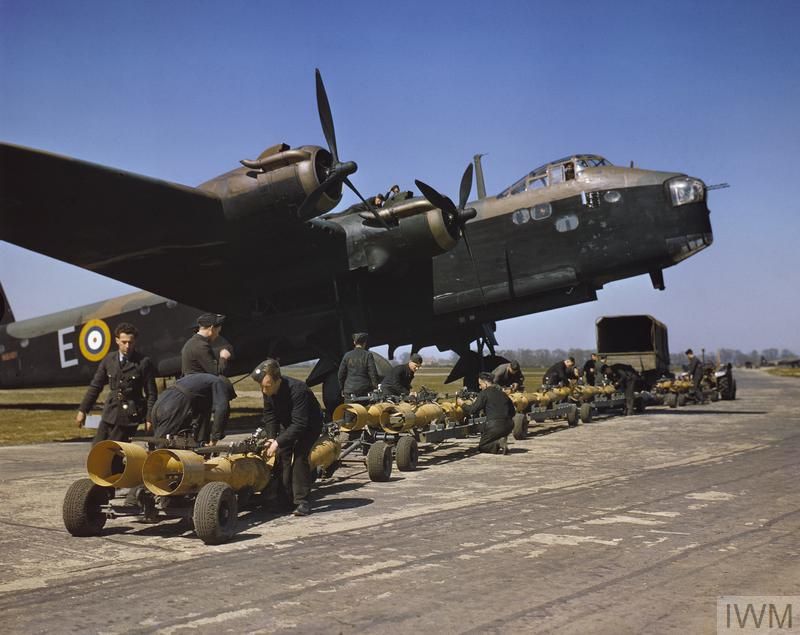
Bomber Short Stirling
Photo : United Kingdom Government - Public Domain - © Imperial War Museum IWM TR 8
Crew (No. 299 Squadron RAF - 38th Group)
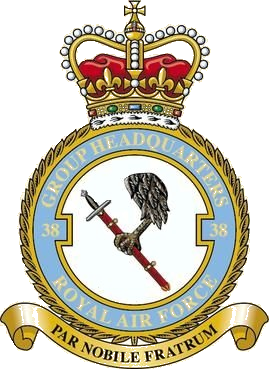
38th Group RAF
All the members of the crew are buried in the municipal cemetery of Plougoumelen
- Pilot Officer (pilot) Henare Whakatau URU (RNZAF), 23 years old, service number 39589
Son of Henare Whakatau URU and Gladys Constance May URU, born ROGERS, of Christchurch, Canterbury, New Zealand.
From January 9 to April 9, 1943, completed Pilot Training Course # 8 at 34 OTU at Pennfield Ridge Air Station, New Brunswick, Canada.

- Warrant Officer (navigator - bomb aimer) Robert Jack BRADDOCK (RNZAF), 26 years old, service number 416081
Son of Alfred and Annie Maud BRADDOCK, Upper Hutt, Wellington, New Zealand
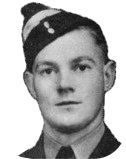
- Flight Sergeant Leonard Allan EUNSON (RAAF), 24 yeras old, service number 410536
Born October 18, 1919 in Northcote, Victoria, Australia.
Only son of Frederick Charles and Mabel Kate EUNSON living at No.11 Walsall Avenue in Preston, Victoria, Australia.
Educated at "Tyler Street State School" in Preston and then enlisted in December 1941
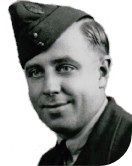
- Warrant Officer Class I (gunner) Gordon Fletcher HARRISON (RCAF), 24 years old, service number R/112810
Born September 28, 1920 in Toronto, Ontario, Canada. He studied at Strathcona Public School and Western Tech School.
His parents lived at Huron Street in Toronto, Canada. He had 4 sisters: Mrs Alberta ANDREWS, Alfreda JORDAN, Gladys JELLIMAN and Miss Dolly HARRISSON.
He enlisted in July 1942 and completed his training at RCAF MacDonald Base at No. 3 Bombing and Artillery School. He joined England in May 1943.
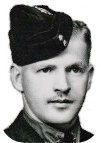
- Sergeant (Flight engineer) Alfred Anthony HULL (RAF Volunteer Reserve), 20 years old, service number 1588979
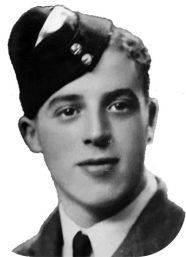
- Pilot Officer (radio operator - gunner) Walter Nelson IRVING (RCAF), 25 years old, service number J/87928.
Born February 6, 1919 in Saskatchewan, Canada. Lived in New Westminter, British Columbia, Canada.

THE STORY
Operation "S.A.S. DINGSON 35B"
All times given are in English time and taken from the Operation Record Book and parachute drop reports of 299 Squadron of the RAF. In August 1944 the time difference with French time was one hour, 12 hours English time meant 13 hours French time.
On August 5, 1944, between 10:15 p.m. and 11:47 p.m., 14 Stirling Mk IV bombers of the 299 Squadron of the RAF took off from the base of Keevil, County of Wilshire, for parachuting operations on French territory. They were distributed as follows :
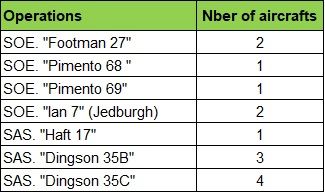
The 299 Squadron is part of the squadrons of the 38th Group RAF, called "Special duties". These squadrons carried out during WWII parachutes and pickups of agents of SOE, IS, SAS, JEDBURGH, BCRA, but also towed gliders, parachuted troops, weapons or jeeps for the SOE, SAS, JEDBURGH and the French resistance.
Situation of Squadrons RAF "Special duties" in June 1944 :

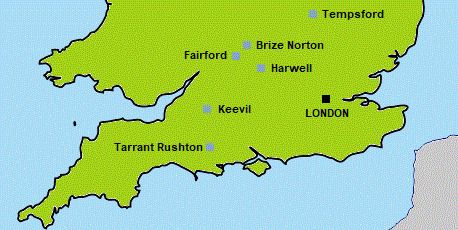
It was therefore from the RAF base in Keevil that 3 Stirling (out of the 14) took off on August 5, 1944 for the S.A.S. operation "Dingson 35B":
- one flown by Flight Lieutenant TAYLOR at 10:33 pm.
- one flown by Pilot Officer TOWELL at 10:43 p.m.
- and the one flown by Pilot Officer URU at 11:00 p.m.
In the "Operation Record Book" of the no 299 Squadron RAF, the aircraft of P/O URU was erroneously noted for a "IAN 7" parachuting operation for the benefit of the Jedburgh IAN team. This operation "IAN 7" was carried out that same night, from August 5 to 6, 1944 by two Stirling Mk IV bombers of the no 299 squadron flown by Flight Officer GOUCHER and Warrant Officer DILLON at a place called "Fougères" in the town of Cherves-Châtelars, located in the department of Charente.
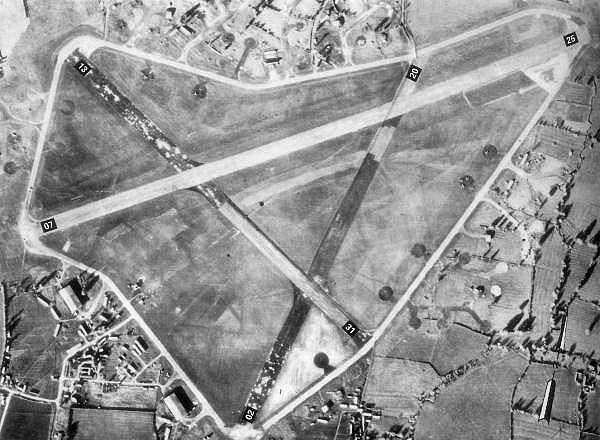
Aerial photo of Keevil airfield (taken in 1956)
Photo : United Kingdom Government - Public Domain
The crews of the 3 Short Stirling Mk IV of Operation S.A.S. "Dingson 35B" were :

Each aircraft carried 24 containers of guns and ammunition for the local Resistance. The objective was a dropping zone located near a place called "Kerlias" in the town of Plescop, department of Morbihan. (RAF coordinates: 47 ° 42N, 02 ° 51W). "Kerlias" was located between the municipalities of Mériadec and Plescop1. Pilot Officer URU's crew were carrying out their 11th operational mission as well as their bomber the Stirling Mk IV, coded 5G-T, serial number LJ878. The aircrafts used by the no 299 Squadron were "Short Stirling Mk IV", four-engine bombers, which were in fact "Short Stirling Mk III" whithout front and dorsal machine guns and with a hook for towing. gliders under the rear machine gun.
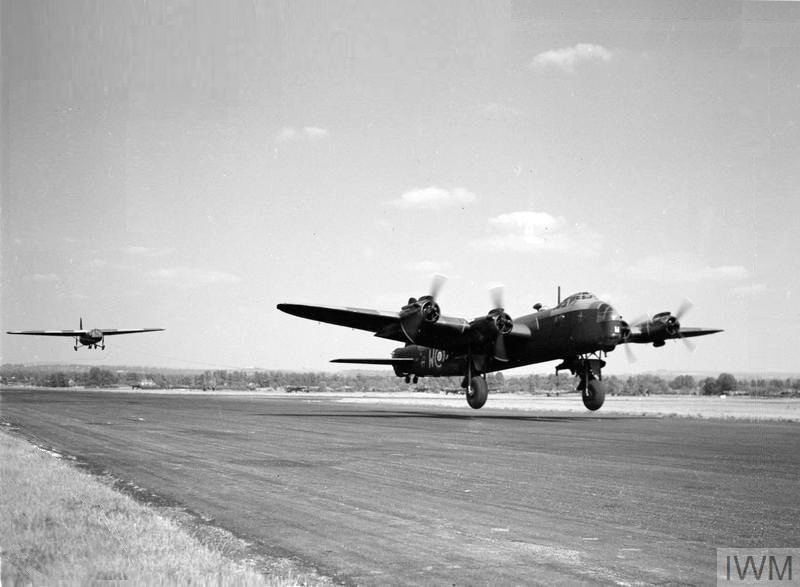
Short Stirling of no 196 Squadron RAF taking off towing an Airspeed Horsa
Photo : United Kingdom Government - Public Domain - © Imperial War Museum IWM CH 18786
1 Until today, despite the research carried out, it has not been possible to determine exactly for which unit of the Resistance was intended this parachuting of weapons requested by the Paratroopers of the 4th SAS Battalion (Parachutists of the Free French Air Forces, incorporated in the British elite special forces unit of the Special Air Service, to the 3rd and 4th Battalions). In the Auray sector, there was the 2nd Battalion of the French Interior Forces of the Army Resistance Organization commanded by Commander LE GARREC, alias "Commandant Yves", alias "Bénard". We can only suppose that this parachuting was intended for the resistance fighters of the ex-Maquis of the Treuroux's mill, of the 2nd FFI Battalion ; the latter had been denounced and attacked on July 10, 1944 by the Germans.
The aircrafts entered French territory via Pléneuf and finished the parachute drop zone at 12:10 am for F/Lt TAYLOR and at 12:16 am for P/O TOVELL. They flew around in circles for 20 and 31 minutes respectively in the Auray sector, in vain, while waiting for signals from the light beaconing of the parachuting field by the reception committee.
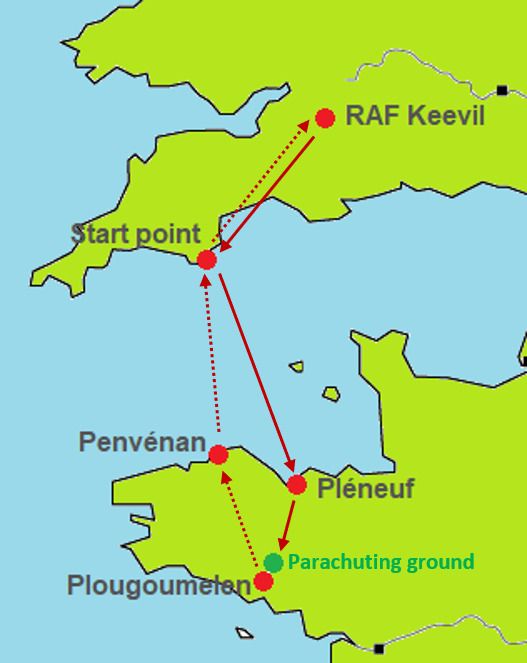
Le trajet des avions
The reports of the R.A.F. pilots
Flight Lieutenant TAYLOR :
Baden :
- at 12:25 am, at an altitude of 460 meters, fire from the light Flak.
- at 12:30 a.m. an aircraft fallen. A large sheet of flames. It could be P/O URU and his crew.
Flight Lieutenant TOWELL :
Auray :
- at 12:30 am, at an altitude of 300 meters and at a speed of 350 km/h, hit by shots from the 20mm light Flak which caused holes in the right side of his aircraft.
- at 12:32 am, at an altitude of 300 meters, a falling aircraft crashed into the city.
The arrival time on drop zone of Pilot Officer URU's plane is unknown but it can be estimated at 12:20 am/12:25 am. He was shot around 12:30 a.m. Flight Lieutenant TAYLOR left the Auray sector at 12:30 am and Pilot Officer TOVELL at 12:47 am without having carried out any parachute drops. They left French territory via Penvénan and landed respectively at the RAF base in Keevil at 2:18 am and 2:23 am.
In the Operation Record Book of no 299 Squadron RAF, it is mentioned :
"The Pilot Officer URU and his crew were missing from this operational mission. Flight Lieutenant TAYLOR and Pilot Officer TOVELL were flying on the same mission as the Pilot Officer URU, and reported seeing a falling aircraft in flames overhead. the objective. It is feared that this was the aircraft flown by Pilot Officer URU and, as it was flying at about 460 meters, it is unlikely that the crew would be safe. This crew, who was with the squadron since its creation in November 1943, has taken part in the airborne D-Day operations and has also carried out a number of operations2 (4) for SAS and SOE ".
2 During the night of August 2 to 3, 1944, three Stirling aircrafts (including the same crew of the Pilot Officer URU) carried out the mission "S.A.S. Dingson 32B" with the parachuting of 72 containers and 4 baskets in the region of Auray
The German army report
On August 5, 1944, Colonel BORST's German combat group (Kampfgruppe), which left Hennebont around 6 a.m. with around 1,500 men, had received the order to re-establish the road link between Lorient and Saint-Nazaire via Vannes, as well as to take over the Vannes-Meucon airfield, occupied since August 4 by elements of the 1st Battalion FFI. In his report, Reserve Captain ALBRECHT, commander of 3./Sicherungs-Regiment 191 (3rd Battalion of Security Regiment 191) notes :
"On August 5, my battalion received the order to advance towards Vannes, at the same time as the Battalion BRUGGEMANN which was not yet fully available ; the goal was to take the town which appeared to be occupied by the terrorists. Colonel BORST led the operation.
To my battalion was associated a group made up of light units of the Flak of the Luftwaffe (German Air Force), whose mission was to occupy the airfield of Meucon near Vannes. My battalion reached Auray in the afternoon and encountered resistance from the terrorist formations. After the cleaning of the suburbs on the access road, operation during which the battalion had two dead and many wounded, we reached in the evening the western edge of the city. In Auray, furious combats still raged around some blocks of houses, but resistance was broken by the entry into action of the Light Flak. For the night, the battalion bivouacked in Auray and started again around 3:00 am. An enemy aircraft flying over the road was shot down by 20mm guns from the Flak. "
It is probably by these guns of the German Flak that the aircraft of the P/O URU was hit in the sector of "Terre-Rouge", where this combat group had stationed for the night. Note that the Kampfgruppe BORST, was annihilated on August 6 between Luscanen and Le Fourchêne, by the tanks of "Combat Command A" of the 4th Armored Division of the American army commanded by General WOOD.
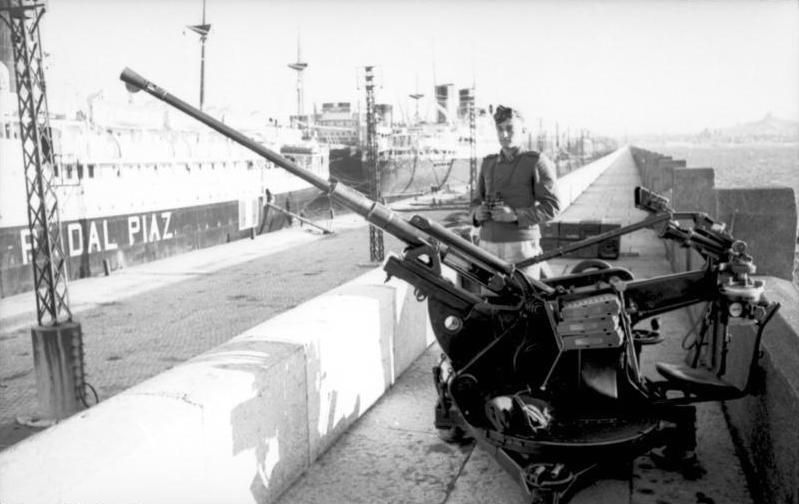
A 20mm Flak 30 gun on a port
© Bundesarchiv, Bild 101I-621-2943-33 / Doege / CC-BY-SA 3.0
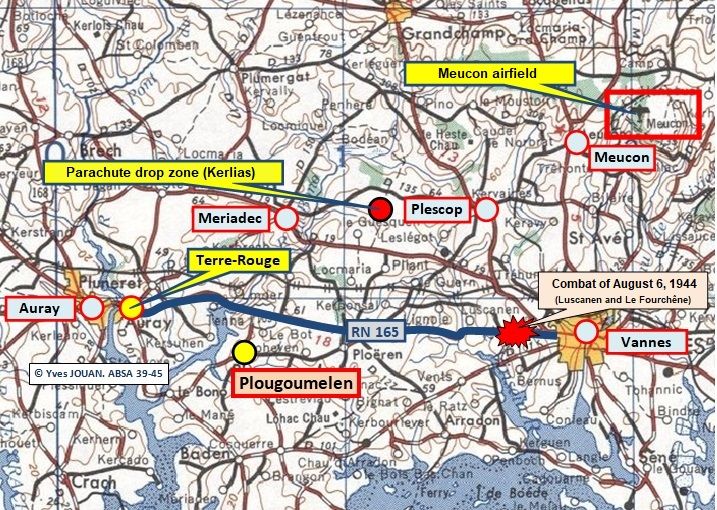
Map of the Auray-Vannes sector on August 5 and 6, 1944
Map designed from a 1944 U.S. Army Engineer map
The fall of the aircraft in the village of Plougoumelen
The aircraft on fire hit two roofs and crashed in the yard between the LE MEUT family farm and the LE RAY family house. The crew members perished in the flames of their Stirling bomber. The buildings of the farms and houses of the LE MEUT, LE CLANCHE, LE SOMMER, LE RAY families catched fire. One of the burning engines rolled and blocked the front door of the LE RAY family house, which perished in the flames.
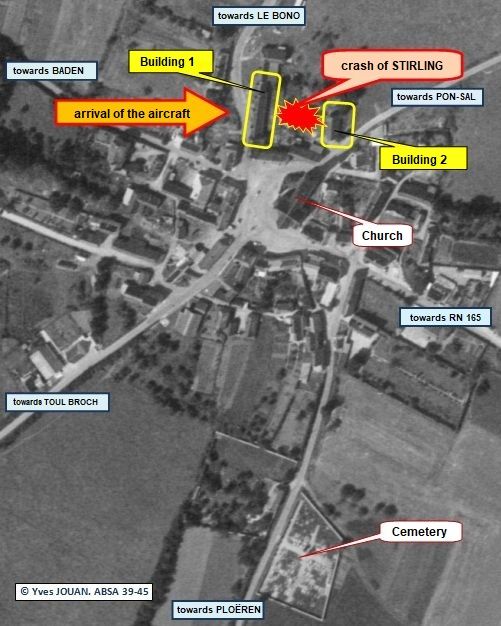
Building 1 : house and farm buildings of families LE MEUT and LE CLANCHE.
Building 2 : house building of families LE RAY and LE SOMMER.
Source aerial photo : IGN, 1952
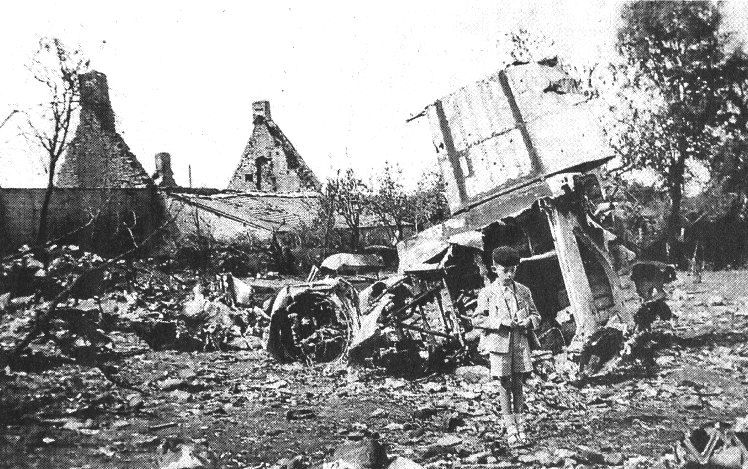
Bertrand DE NOUË in front of the wreckage of the Stirling. In the background, the farm buildings (Building 1 ..). Photo taken on the courtyard side.
Source of photo : Stéphane MORICE
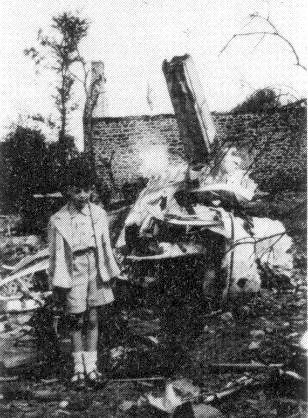
Bertrand DE NOUË in front of the wreckage of the Stirling.
In the background, the house building of family LE RAY (Building 2).
Photo taken on the courtyard side.
Source photo : Stéphane MORICE
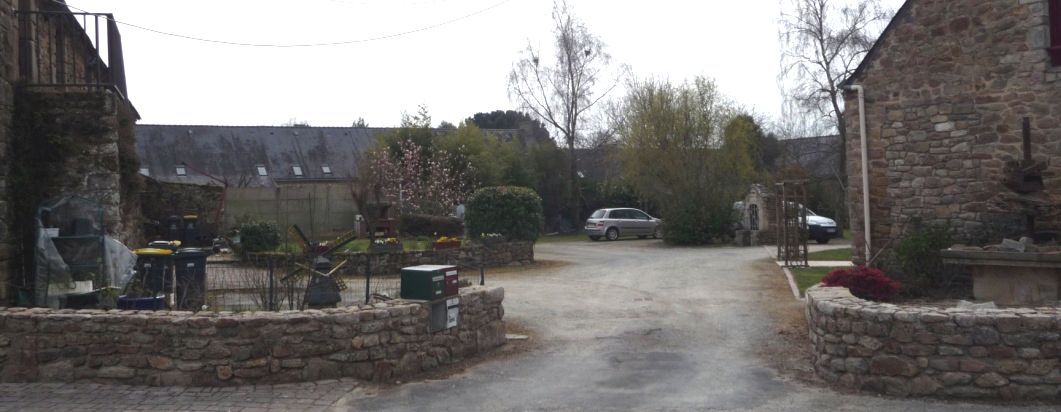
The courtyard where the Stirling crashed and where the photos of the aircraft were taken.
In the background, the former farm buildings and on the right the gable of the former LE RAY family home.
A commemorative plaque is placed on the former LE RAY house, on the Georges Cadoudal street side
Source of photo : Yves JOUAN (ABSA 39-45)
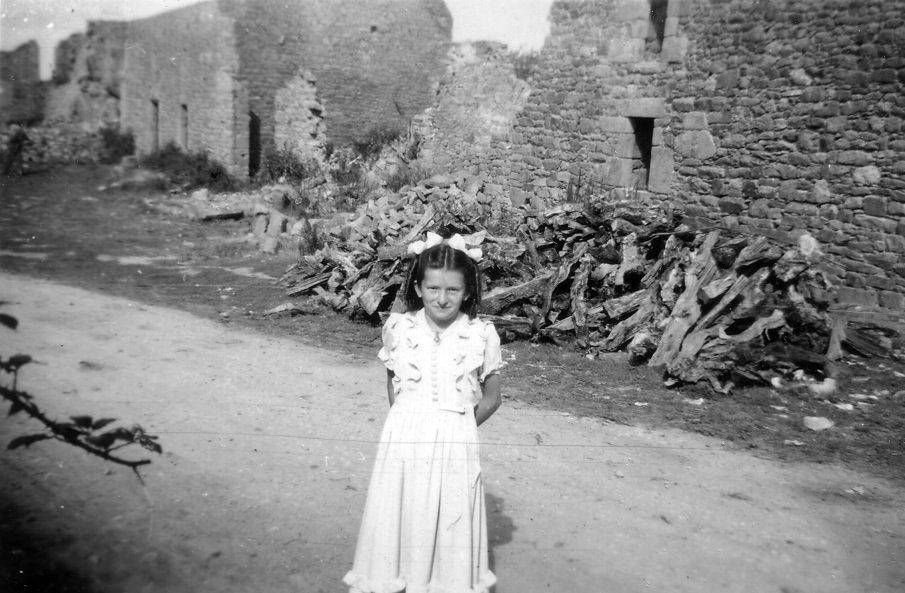
Anne-Marie LE VIGOUROUX, mother of Stéphane MORICE, in front of burnt farm buildings (building 1). Photo taken on the Bono road side
Source of photo : Stéphane MORICE
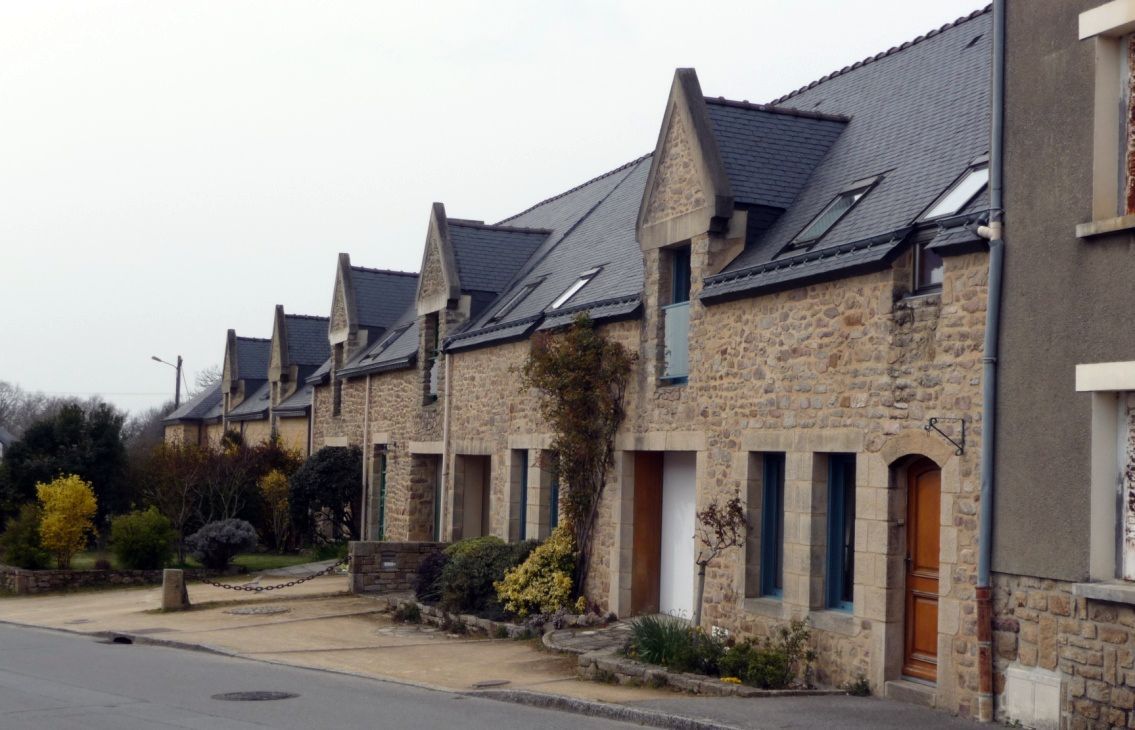
Same photo taken in Bono road, which became later "rue du 5 août 1944" ("street of 5th August, 1944)
Source of photo : Yves JOUAN (ABSA 39-45)
TESTIMONIALS
Mister Pascal LE SOMMER
(testimony collected by Pierre MAHÉ, ABSA 39-45)
Mr. Pascal LE SOMMER, son-in-law of the LE RAY spouses, was married to their daughter Anne-Marie.
On the night of August 5 to 6, 1944, a day before the German troops retreated from Auray, two English bombers, loaded with containers for the maquis in the Auray region, were circling around, trying to see the lights of the F.F.I. to tell them where they should drop their containers. The Germans made signals and one of the two English aircrafts headed towards the signals made by the Germans. They fired and hit one of the two bombers. This one touched two roofs in the village of Plougoumelen and crashed into the courtyard of the LE RAY farm. The aircraft disintegrated and one of the burning engines rolled over and blocked the entrance to the door to the farmhouse and set it on fire. The couple LE RAY and one of their daughter perished burnt in their house. Only the second daughter, who was in a nearby house, escaped death. The six crew members perished in the crash of the aircraft ; they rest in the village cemetery. Only one of the members who did not go in this operation escaped death. The pilot's family, the sister Tui URU, came to the scene of the crash in Plougoumelen in 1987.
Mister Alfred LE ROUZIC, public school teacher
(Source : brochure "5 Août 1944-1994, En mémoire de ceux qui sont morts pour notre liberté" ("August 5, 1944-1994, In memory of those who died for our freedom"), printed by the municipality of Plougoumelen)
August 5, 1944 was to be a Saturday. Thursday morning August 3, I went to Auray, to the Post Office to collect our money orders. In the office, I met the Director of the public school of Pluneret, Mr. LE MENY, whom I knew very well and who told me about the news of the day : the American columns surging from Avranches were going to cut Brittany towards the ocean. I also heard this news about London during the night and he said to me : "in two days I will have a parachuting of weapons in Pluneret". On Saturday 5th, Jeannette QUERNEC came from Vannes as usual. In the evening, we listened, Raymonde and I, London on two galena stations placed in chalk boxes. We had the press release for tomorrow. It was very hot, I was in a sweater and woolen underpants. When we went back to bed, I heard the purring of an English aircraft and I thought of the words of the colleague. I went to the dining room window. The aircraft flew low, huge. It was the parachuting , it flew over me ... normal noise and it continued. A second aircraft flew higher, but in the same direction. A few minutes passed, I could no longer hear the sound of aircrafts, then in the direction of Auray I heard a dull crackling, but the sound of the plane was coming back ... I thought for a moment that I had made a mistake and that, perhaps, it was German aircrafts which machine-gunned.
For several weeks, a group of Canadian and French paratroopers had been circulating in the fields and harassing the Germans in Baden, Auray ... Perhaps they were caught by the German aircrafts. The two aircrafts passed and performed their loops. They came back : the first one was lower, the engines, from time to time, were accelerating ; soon I distinguished a flame at the base of the tail. The aircraft was still going down and I thought it was falling on the school. No. He flew just over the roof ... I left the window and ran to tell my wife and our friend. We took the baby and went down into the dark to come out through one of the classes which had a free door : the door of the Town Hall was locked. There, I heard an explosion and saw a bright glow. We went down the road to the second school. I thought the aircraft might contain bombs and we took refuge behind the cemetery wall. Once the family was safe, I went into the house to get some clothes : the women were in night-dresses and pyjamas. Then I came back to the village in front of the church : the flames were illuminating the bell tower, the second aircraft was still turning but had risen and soon it was leaving.
In front of the LE SOMMER house, people came and went. They had brought out a table, a cradle with the baby. They put a ladder up to the roof to water it and to keep the straw and hay in the attic from catching fire. Behind, a horse did not want to come out of the burning stable, a slightly burnt pig was screaming as it ran away ... the tires of the aircraft were burning with the landing gear with a glow of magnesium ... the aluminum melted and flaming gasoline flowed down the gutter. We thought about the people blocked in their house, we went and looked from behind but it was not possible to help them ... A German soldier came out of the path, threatening us with his machine gun : Terrorist ? No. An English aircraft. And he left. Back in the square, I went up to the roof to help and throw the buckets over the other slope. When my head protruded, a machine gun fired tracer bullets in my direction, so I took cover behind the fireplace. We continued for a very long time. We were called to help Mrs LE SOMMER to get the laundry out of her cupboards, but the laundry caught fire as soon as there was air ... When the sun rose, we were able to approach and see the extent of the disaster. I collected the crew's plates and a box of documents that were given to the Town Hall and to the officer who came to collect them. Mr. Paul BAINVEL, carpenter, took care of the coffins to bury the airmen. The day of the burial, and during the ceremony, the group of Paratroopers took up position and a group of Resistance fighters paid the honors.
MisterJoseph LE VIGOUROUX, inhabitant of Plougoumelen.
(testimony collected by Stéphane MORICE, March 1993)
This happened in the town of Plougoumelen around 11 pm, during the night of August 5 to 6, 1944. I was 16 years old. An English aircraft loaded with light weapons and ammunition, intended to deliver its load to the resistants located in this sector. The Germans, our occupants, having learned of the "way" to locate the drop site, lit a fire during the night in the area of St Avoye en Pluneret, at a place called "La Butte". The airmen, thinking they to reached their goal, made their aircraft lose altitude in order to deliver the containers in the best conditions. It was then that a German battery, installed at the Butte, strafed the aircraft which was hit, which caused a fire on board. Moments later, as the fire spread, the aircraft lost more and more altitude and speed. During the night, the roar of the engines became more and more impressive.
As very often at this time of German occupation, I used to sit in the evening, at the open window in my room, on the first floor of the current bar-tobacco shop in the town of Plougoumelen, to attend the "carousel" of the American flying fortresses, coming to bombard Lorient and the fireworks provoked by DCA fire, tracer bullets and multicolored flares. Coming from the back of our house, I couldn't see the burning aircraft, but its noise was getting heavier and heavier. Suddenly, for a very, very short moment, I saw the shadow of the aircraft passing over the little square in front of me and over the roof of the church. Immediately there was an enormous noise. The aircraft had just crashed and exploded, which caused not far from me a part of the town on the west side to catch fire. The next day, Sunday, around 5 p.m., it was the arrival in the village of our liberators, the Americans, with their tanks
Mrs Agathe LE VIGOUROUX
(testimony collected by Stéphane MORICE, January 2002)
I was 11, I'm 68 and I remember before it was too late, I tell and write. Saturday August 5, 1944. With my brother Joseph (16 years old), my sisters Mélanie (14 years old) and Anne Marie (9 years old) and our mother (Daddy had died 15 days previously on July 13), we lived in the village of Plougoumelen, 17 Church square (current bar-tobacco shop) where Mum had a bar. Like every evening, we went to bed at a reasonable time. Around 11 pm, my brother came into our room, panicked: "get up and follow me". He took Anne Marie in his arms and repeated "follow me, an aircraft has fallen on the town". Mélanie and I, frightened by the outside noise, went down the stairs and went out after him. Outside, the LE MEUT and LE CLANCHE farms were on fire. My brother took us to the road towards Béquerel, and dropped us off at the turn before entering the current “les genêts”. Anne Marie was still sleeping. We spent a good part of the night there, scared to death. We could see this whole part of the village, the entrance to the Bono road, in flames, with detonations. The aircraft was loaded with ammunition intended for the Resistants. The wind, fortunately very weak, made flaming bits of straw fly above us, coming from the burning cottages, then that fell in the fields (currently "Les Genêts" and "J.P. CALLOOCH" parking lot). During the night, we heard, on the road towards Béquerel, men walking cautiously, wondering what was going on. They carried weapons, ready to shoot. They were Resistants stationed at Moulin Héric.
Recovered by I do not know who, we spent the end of the night in a room in the presbytery (former presbytery, currently at 5 "rue Notre-Dame de Béquerel"). The three of us had slept there a little in the same bed and above all observed from the window this terrible picture of fire accompanied by the noise of the ammunition exploding and the mooing of the cows trapped in the stables on fire. In fact, the land next to our house was an area of the LE MEUT farm which was on fire across the street. At the beginning of August, the harvest was done and a few meters from our house, a mulch of sheaves of wheat awaited threshing. On the other side of this straw, barely 10 meters away, a building, the cellar of the farm (the "Teichistr") was also on fire. Fortunately, the wind, not very strong, directed the flames to the south towards a field without construction. The incessant watering of the mulch by volunteers with buckets of water from the surrounding wells, and carried by a chain of men also made it possible to block the fire. There was no way to call for help, no phone, everything was cut off. Two volunteers, François LE MENTEC and Paul BAINVEL, decided to cycle to Auray to warn the firefighters. Unfortunately, on the national road they were taking, the column of Germans who had just strafed the aircraft stopped them and kept them gun raised, until the morning : “you terrorists”. This American aircraft (in fact english) was loaded with ammunition intended for groups of resistance fighters hidden in the region, who were supposed to allow it to drop its load through signals. But, reported to the Germans who gave it false signals, he gradually lost altitude and was machine-gunned by this column of Germans. On fire, with airmen probably loosing control, the aircraft circled above the western part of the village to finally fall on the LE MEUT farm, opened in its middle and on the courtyard of the LE RAY house.
- 2 farms burnt (LE MEUT, LE CLANCHE),
- 3 houses burnt (LE RAY, LE SOMMER and a house occupied by refugees from Lorient),
- 3 civilian casualties, Mr and Mrs LE RAY and their daughter,
- 6 military casualties, the airmen,
The next day, Sunday August 6, it was desolation, smoking ruins, acrid smells of smoke, distressed, tired and sad people. In the afternoon, the village was full with people coming from the surrounding area to realize what had happened, our bar was full. Suddenly, we heard the noises of trucks approaching more and more of the village. They were German trucks loaded with defeated soldiers. When they saw them, the crowd of visitors fled from all sides. The Germans fired several bursts of machine guns. Fortunately in the air because there was no victim. They passed and took the direction of Bono. A lot of fear, but the streets of the village filled up again when at the end of the afternoon, new noises, louder and louder. But this time, it was crazy, it was American tanks and their soldiers. Everyone surrounded them, greeting them and throwing them flowers. It was relief. These Americans spent the night in the woods of Kervilio. As for the Germans at the start of the afternoon, at Bono, they had taken the direction of Baden where they were machine-gunned by resistance fighters who kept watch in the Baden bell tower : burnt trucks, soldiers killed, the others scattered, escaped into the countryside and crossed the river to reach Crac'h.
IN MEMORIAM
In memory of the victims of the crash
60 years after the tragedy, on August 5, 2004, at the initiative of the LE CORFF-TINTINGER spouses, great-grandchildren of the LE RAY family, a plaque in memory of the civilian victims and the crew was inaugurated and affixed to the back of the former LE RAY family dwelling, on the Georges Cadoudal street side.
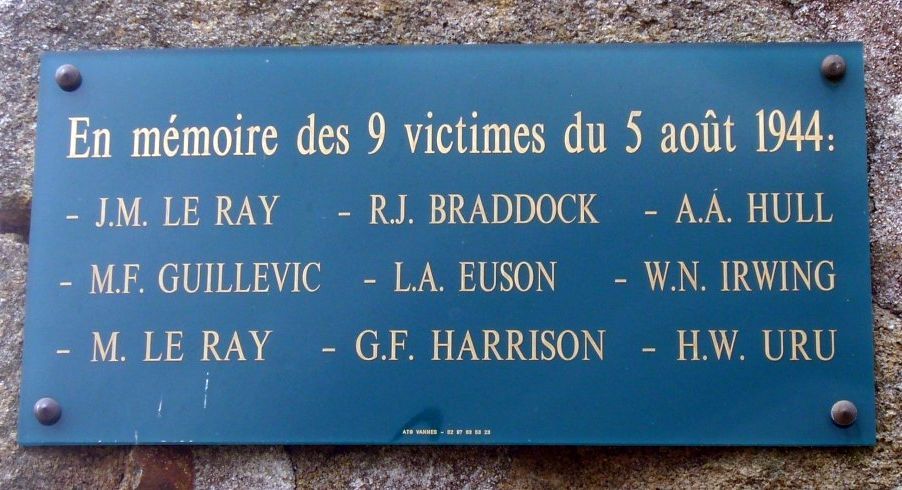
"In memory of the 9 victims of 5th August, 1944"
Source of photo : Yves JOUAN (ABSA 39-45)
- LE RAY family :
• Jean-Marie LE RAY (father), 66 years old, born on 11th March 1878 in Plougoumelen (56).
• Marie, Françoise GUILLEVIC, spouse LE RAY, 67 years old, born on 6th April 1877 in Plescop (56).
• Mathurine, François, Marie LE RAY (daughter), 31 years, born on 25th April 1913 in Plougoumelen (56).
- The 6 crew members of the Stirling were killed. Below some photos relating to these airmen.
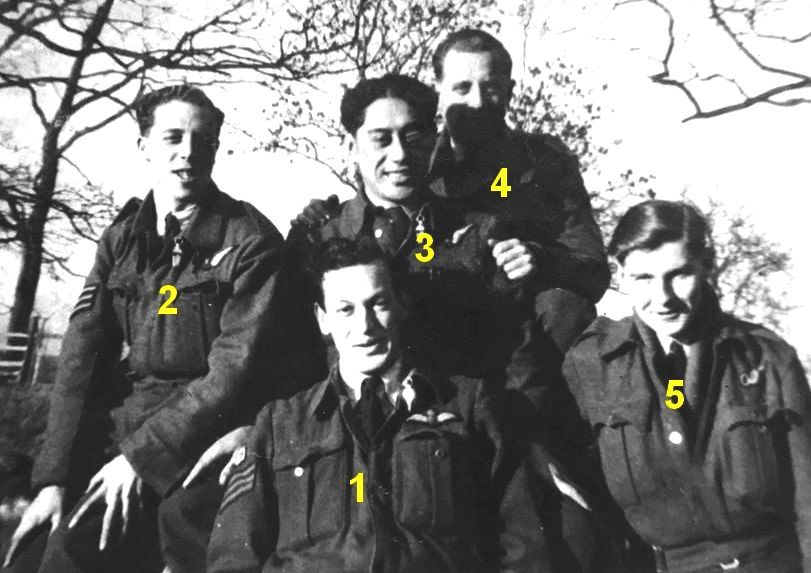
n°1 : P/O Henare W. URU, n°2 : Sgt Alfred A. HULL, n°3 : F/Sgt P. TAYLOR3, n°4 : F/Sgt Leonard A. EUNSON, n°5 : not identified
Source of photo : Jonathan IVES
3 Flight Sergeant P. TAYLOR, radio operator - machine gunner was not present on the aircraft on August 5, 1944. He was wounded on June 6, 1944 by German DCA fire during the "TONGA" parachute drop operation of the 12th Battalion of the 6th Division British Airborne
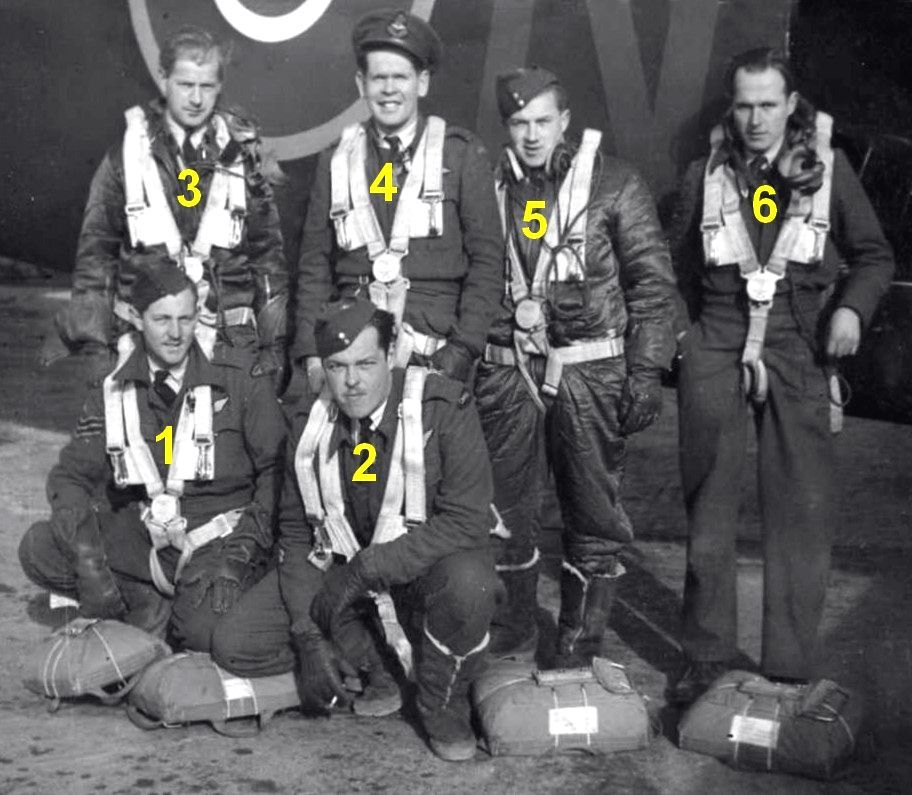
n°1 : could be W/O Gordon F. HARRISON, n°2 : not identified, n°3 : P/O Walter N. IRVING, n°4 : not identified, n°5 : could be F/Sgt Leonard A. EUNSON, n°6 : not identified.
This photo, of a crew of No. 299 Squadron RAF, is from Bill IRVING, Walter's uncle. The only certainty is the identification of Walter IRIVING. The photo was reportedly taken at RAF Stoney Cross base
Source of photo : Bill IRVING
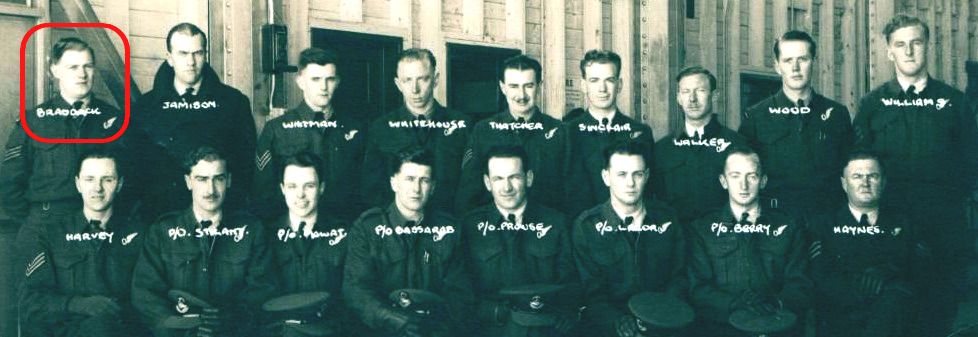
Robert Jack BRADDOCK during Navigator Training #8 from January to April 1943, at 34 Operational Training Unit at Pennfield Ridge Air Station, New Brunswick, Canada
Source photo unknown

Leading Aircraftman Leonard Allan EUNSON during Training # 30 (1943) at Bombardment and Artillery School # 2 in Port Pirie, South Australia.
Source photo unknown
The stones of the Commonwealth military square in the communal cemetery of Plougoumelen, where the airmen rest in a collective grave

Source of photo : Yves JOUAN (ABSA 39-45)
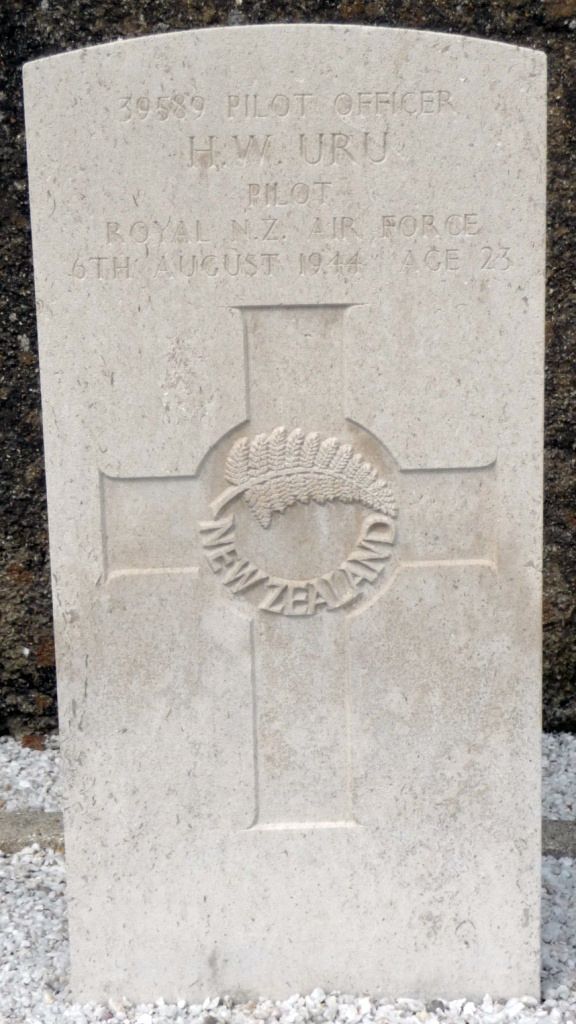
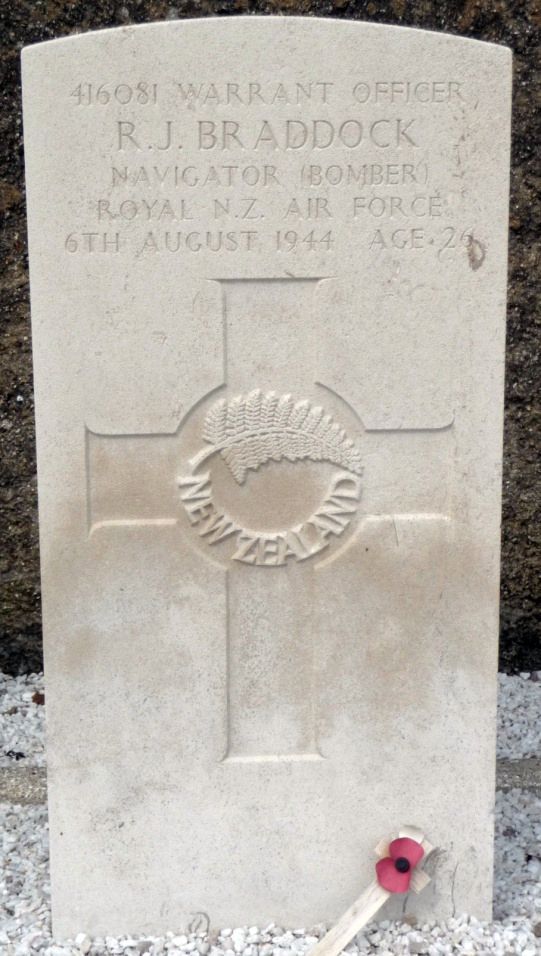
Source of photo : Yves JOUAN (ABSA 39-45)
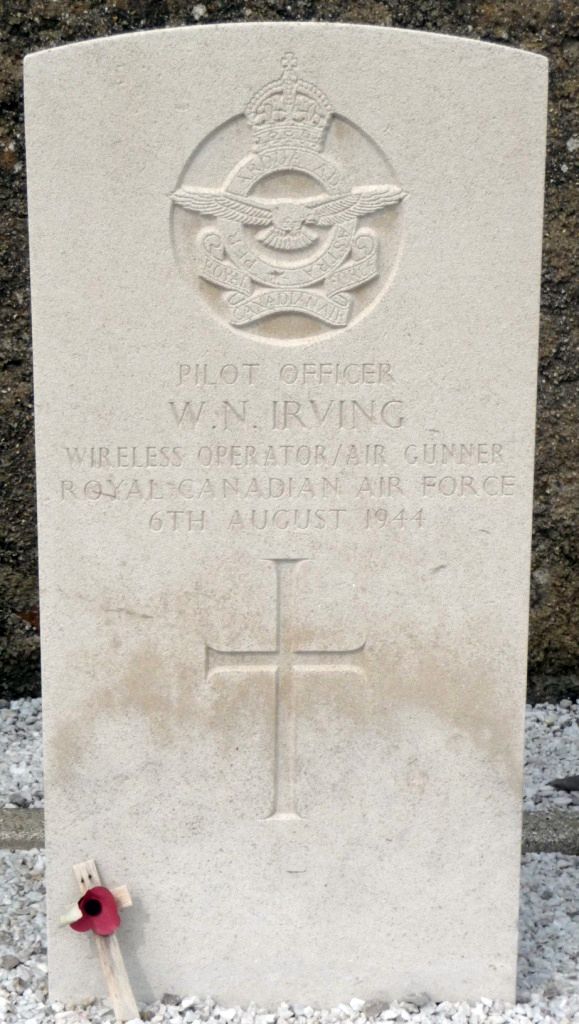
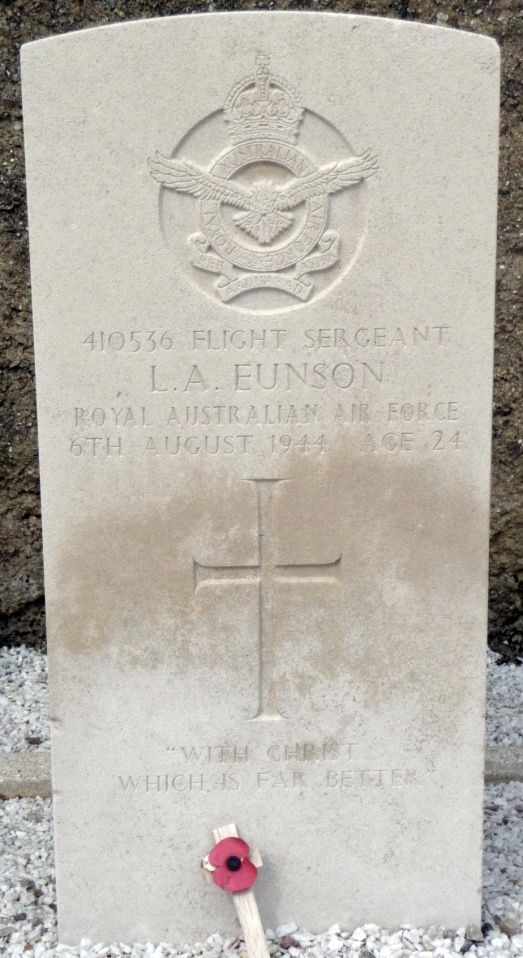
Source of photo : Yves JOUAN (ABSA 39-45)

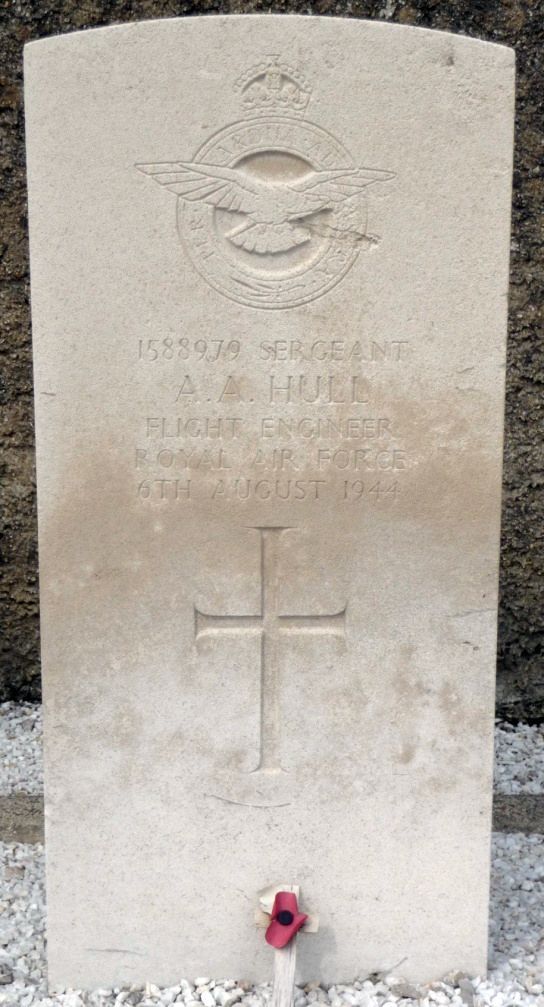
Source of photo : Yves JOUAN (ABSA 39-45)
IN THE PRESS
• Article of 2nd June 2004 (source Stéphane MORICE)
The downed aircraft made nine victims, on the eve of the liberation of the town
5 August 1944 : the hell in Plougoumelen !
At 76 years old, living in Auray, Joseph LE VIGOUROUX has the fresh memory of the famous night of August 4 to 5, 1944, when a four-engine bomber of the Royal Air Force was shot down over the town of Plougoumelen, causing nine victims, devastating several buildings. A town in mourning, the very day it was released. "I was 16 years old. I lived with my mother and my three sisters, younger than me, in the current bar-tobacco shop, facing the church", tells Joseph LE VIGOUROUX. "On July 14, we had just buried our father, soldier of the 14-18 war, with the veterans' flag ahead to go to the cemetery, while a patrol of German soldiers drove through in a truck and remained unresponsive. "
The ballet of the flying fortresses
He remembers everything: " At home, our two bedrooms were upstairs. Frequently, in the evening, the city of Lorient was bombarded by flying fortresses coming from England. They flew across the sky over Plougoumelen, either heading Saint-Nazaire to drop their remaining bombs, or to turn around on Lorient and return to their bases. During these bombardments, very often, I got out of bed to go to the window. I used to witness the searchlights sweeping the sky, the explosion of Flak shells, the ballets of flares and multicolored tracer bullets. What fireworks ! "
The distant spectacle was suddenly approaching. “ Tonight, Saturday August 5th, awake, an abnormal purr attracted me to the window. Again, it was around 11:30 pm. The purr was getting louder and louder. I could feel the aircraft at low altitude, coming from behind our house, that is to say from the south of the village. The noise became deafening and then in the village totally lit up, the shadow of an aircraft, a few seconds, paraded on the roof of the church, in front of me. And instantly, it was the explosion, the fire, the gigantic flames very close to the steeple of the church. A few meters on the left, the agricultural buildings LE MEUT which burned. It was terrible ! I made everyone leave, first taking my youngest child, 9, in my arms to lead her to the Bequerel road and to place her in the trench-shelter, dug in our garden. Back home, it was panic. People were mad, the armed resistance fighters arrived in the village, walking or by bicycle. "
20 meters only
" 20 meters from our house, to the left of the "route du Bono", the LE MEUT cellar building was on fire. Between the two buildings, in the threshing area, two large heaps of straw - the harvest could not yet have been threshed - have been preserved. From this cellar, where we found a wing of the aircraft up to the farm of LE LAYEC, it was over a hundred meters that this part of the village blazed and also the aircraft with its reserve of kerosene, and maybe also his crew ?"
It was horrible. " The house of Mrs Pascal LE SOMMER, where her parents and her sister lived, was at the heart of the blaze, and could not be saved, just like the six airmen who were discovered the next day, Sunday, in the smoking remains of the aircraft. The causes of this catastrophe ? The major version says that this aircraft came to drop containers of weapons, ammunition and other equipment to the resistance stationed in the sector. The Germans would have been aware of the dropping conventions, and they knew that the aircraft had to loose altitude. That's why it was machine gunned by a German battery located on Pluneret/La-Terre-Rouge, which ignited the aircraft. "
August 6 : afraid of American tanks! !
" This Saturday night, huge flames - several tens of meters high - visible from several kilometers around, had attracted, the next day, Sunday August 6, in our small town, a large crowd ", remembers Joseph LE VIGOUROUX. "We had never seen so many people ! And our bar was, unfortunately, full of customers. This tragedy had made nine victims (three civilians and six soldiers of several nationalities), all buried in the cemetery of Plougoumelen."
" In addition to the buildings burned down, a declaration regarding the LE MEUT losses, for insurance, noted the following losses :
16 cattle, 1 bull, 4 heifers, 11 dairy cows, 8 sheep including three small, around 12 tonnes of hay, 300 liters of cider, declaration dated 23 August 1944. "
Joseph LE VIGOUROUX had a love for details. “ This Sunday afternoon had given us very strong emotions. The remains of the aircraft were still smoking, ammunition exploded from time to time. The town was full of people. two or three military trucks, not covered, crossed the square, and fired several shots, heading towards Le Bono. The German soldiers, who were in disarray, certainly did not intend to kill, since there were no casualties. Because of general panic, the bistros were already full - there were six bistros at that time - but now they were full. People were looking for refuge everywhere. At our home, they were in a rabbit shed, in the cellar among the barrels ! Others fled, out of the village, some crossed the Sal river (including probably father LE BERRIGAUD), to reach the other Pluneret side. "
Cigarettes and chewing-gum
The situation was changing. “After this passage of the Germans, people gradually reappeared, timidly, in the square and around the remains. Many returned to their homes in the neighboring towns. No one felt safe. Without information, we did not know where the Americans were. 5:30 p.m., new panic. Coming from Pont-Sal, we heard a very noisy rolling of military equipment. We were still running to hide. "
" Quickly, the square was emptied when the American tanks arrived. No one to welcome them ! It did not last long, we ran again, but this time towards the liberators. We shouted, we sang, we climbed on the tanks stopped. The soldiers distributed cigarettes, chewing gum, chocolate, etc. " " It was the great happiness ! And then the tanks continued their journey towards Le Bono. Thus, in less than a day, Plougoumelen had lived a lot of emotions, before being released from four years of occupation. "
• Article OUEST-FRANCE dated 5th August 2004 (source Stéphane MORICE)
Remembrance ceremony for the crash of an allied aircraft in Plougoumelen
Testimonies on August 5, 1944
On Saturday August 5, 1944 around 11:00 p.m., a few hours before its liberation, Plougoumelen experienced tragic moments. An Allied aircraft crashed in the middle of the village on the house of the LE RAY family, killing the three occupants and the six airmen in the fire. Thursday evening, on the occasion of the sixtieth anniversary, a plaque in memory of the nine victims was set up.
Veterans associations were present at the ceremony as well as officials and personalities and descendants of the LE RAY family. After the laying of a wreath in memory of the victims, the mayor recalled that the couple LE CORFF-TINTINGER, great-grandchildren of the family, were at the initiative of this ceremony.
" Thank you for being so many of you to pay tribute to the LE RAY spouses and to the allied airmen who died in terrible conditions. The mission of this aircraft was to parachute weapons in the area and in Loire-Atlantique. Children must know that wars are terrible times ” said Jean-Claude GUIZIOU.
Then, the commemorative plaque, offered by the municipality, was unveiled by the youngest descendants of the LE RAY family. The procession then proceeded to the cemetery for a ceremony at the graves of six New Zealand, Canadian, British and Australian airmen.
René LE MENTEC, 83 years old, still very healthy, has his memory intact.
" I was leading twelve FFI of the second battalion of Auray. On the evening of August 5, we were stationed around Pluneret, by the roadside. We could hear the Germans passing by, who were retreating towards the Lorient pocket. An aircraft arrived, and turned two or three times. The Germans then lit a searchlight to attract it and then opened fire and damaged the aircraft. The night was not very dark, the aircraft was flying perhaps a hundred meters above the ground, we could see it very well. We then learned that it was coming to parachute weapons in the Pluneret/Sainte-Anne-d'Auray sector. On the other hand, we never knew who was to take care of marking out the field and recovering the cargo."
When evoking these memories, the emotion of Paul BLAINVEL, 84 years old, is still alive. He lived on the church square and on the night of August 5, he remembers it as if it was yesterday. " It was around 11:30 p.m. I heard an aircraft turning and then an explosion. I went to see what was going on. When it crashed, the aircraft had set fire to the farms on the Bono road, and finally ended up on the LE RAY house, which was also on fire. The Mayor, Mr LE MOING, asked me to go to Auray to look for the fire brigade. With Mr LE MENTEC, we jumped on a bicycle and took the direction of Auray. Along the way, we met the Germans, the Kriegsmarine, heading for Vannes. They accused us of being terrorists. "Terrorist kaput," they said. We believed our last hour had arrived. Their commander arrived and it was explained to him the reasons for our presence at night on this road. Against the wish of his men, the officer allowed them to leave. We returned around 5:00 am The people in the village were worried about our absence. The spectacle in the house was not a good to see. As I was a carpenter, I spent my Sunday to make coffins for the aviators, we put two bodies for each coffin, and a small box for the remains of the LE RAY family. " Inauguration of the commemorative plaque, August 5, 2004.
• Article OUEST-FRANCE of August 2, 2019
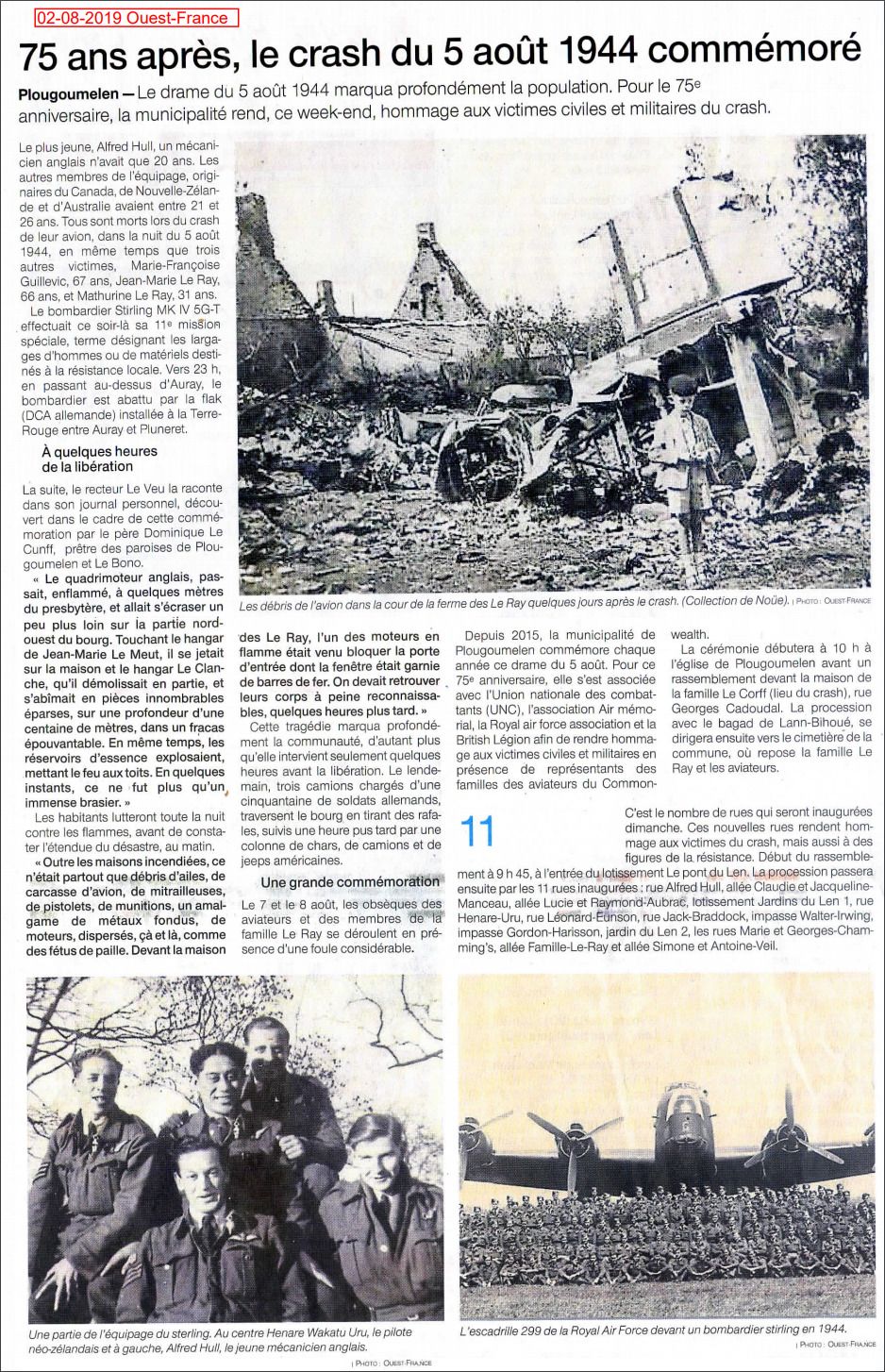
COMMEMORATIONS
♦ August 5, 2015 - Plougoumelen (56)
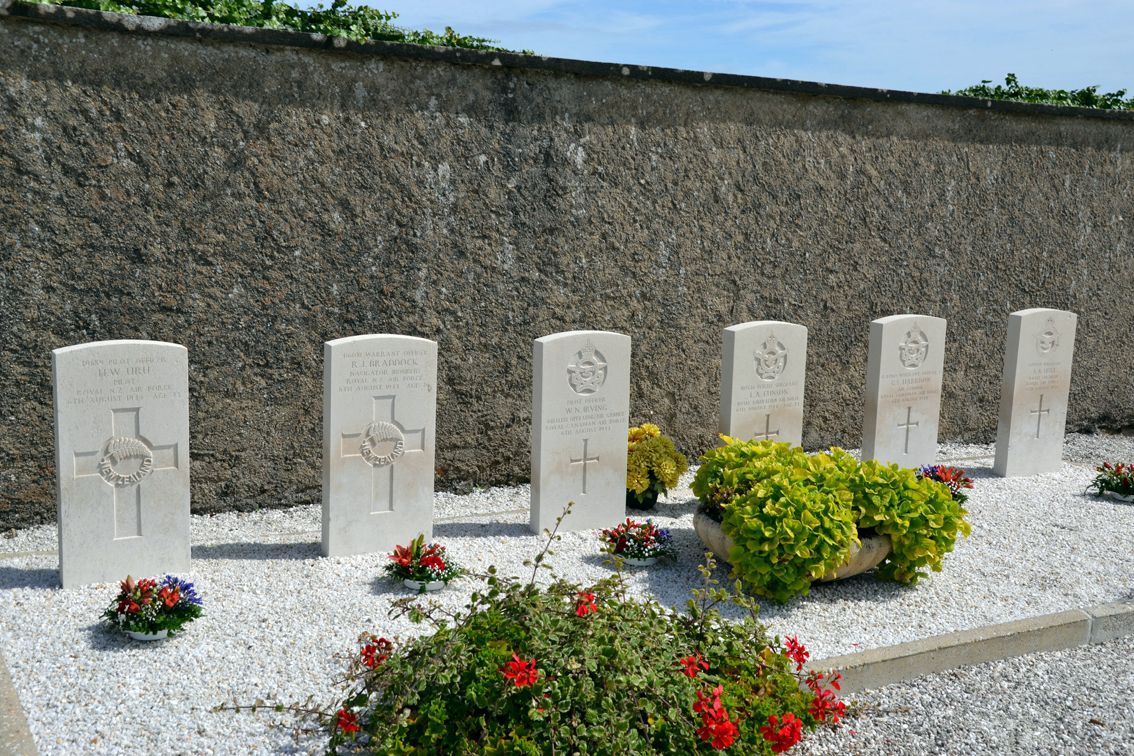
Source of photo : Frank BERNARD (Air Memorial)
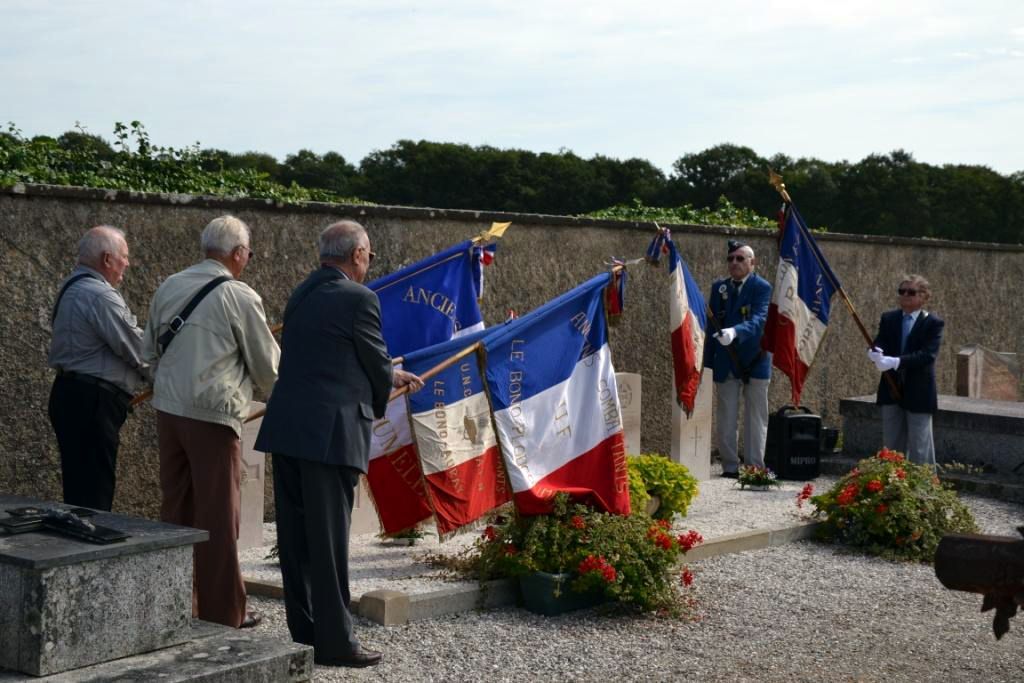
Source of photo : Frank BERNARD (Air Memorial)
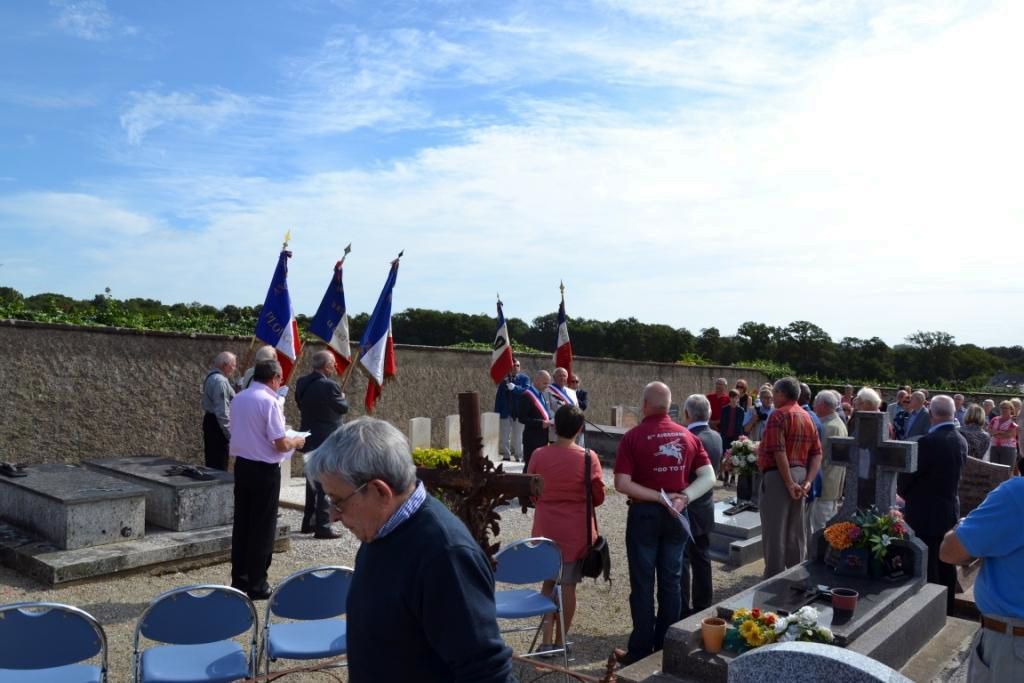
Source of photo : Frank BERNARD (Air Memorial)
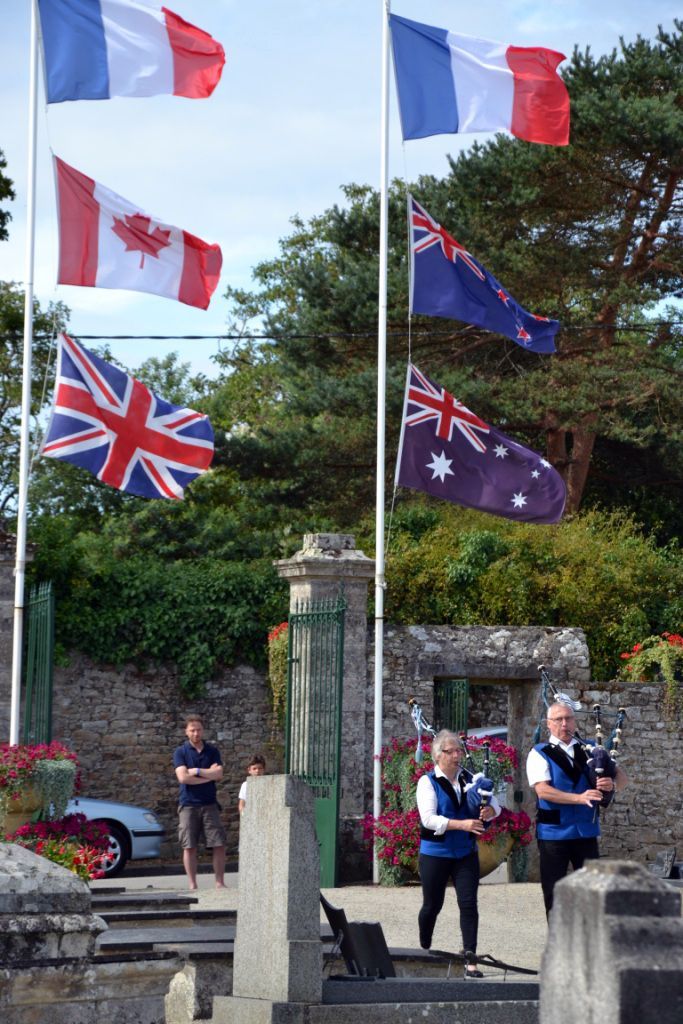
Source of photo : Frank BERNARD (Air Memorial)
The history of this crash was carried out between February 2013 and June 2014.
Update dates : June 2014, September 2014, December 2014, June 2019.
The June 2019 modification concerns photos found during research carried out by Jonathan IVES (ABSA 39-45)
Aknowledgments
To Mr. Stéphane MORICE for his very important help ; by providing documents, photos and a DVD and proofreading this document. Stéphane is the son of Anne-Marie LE VIGOUROUX from Plougoumelen.
To Madame Nadine LE CORFF-TINTINGER, great-granddaughter of Mr and Mrs LE RAY, for information concerning her family.
Documentary and iconographic sources
- The "Operations Records Book" of No. 299 Squadron RAF.
- A DVD ; with press articles, testimonials and photos ; directed by Stéphane MORICE.
- The report of reserve Captain ALBRECHT, commanding 3./Sicherungs-Regiment 191.
- Commonwealth War Graves Commission.
- The brochure "August 5, 1944-1994, In memory of those who died for our freedom", published by the municipality of Plougoumelen during the inauguration of the commemorative plaque.
'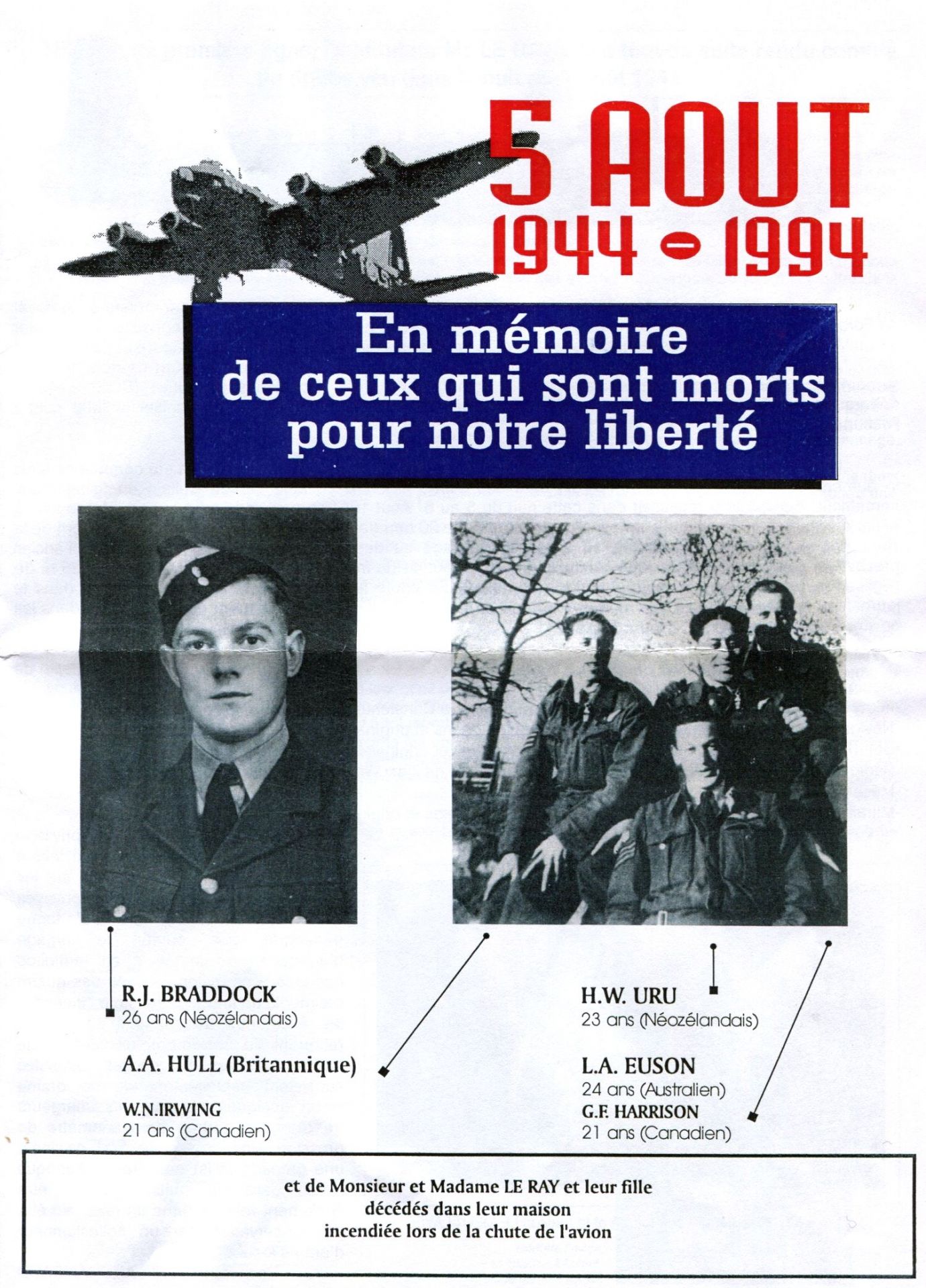
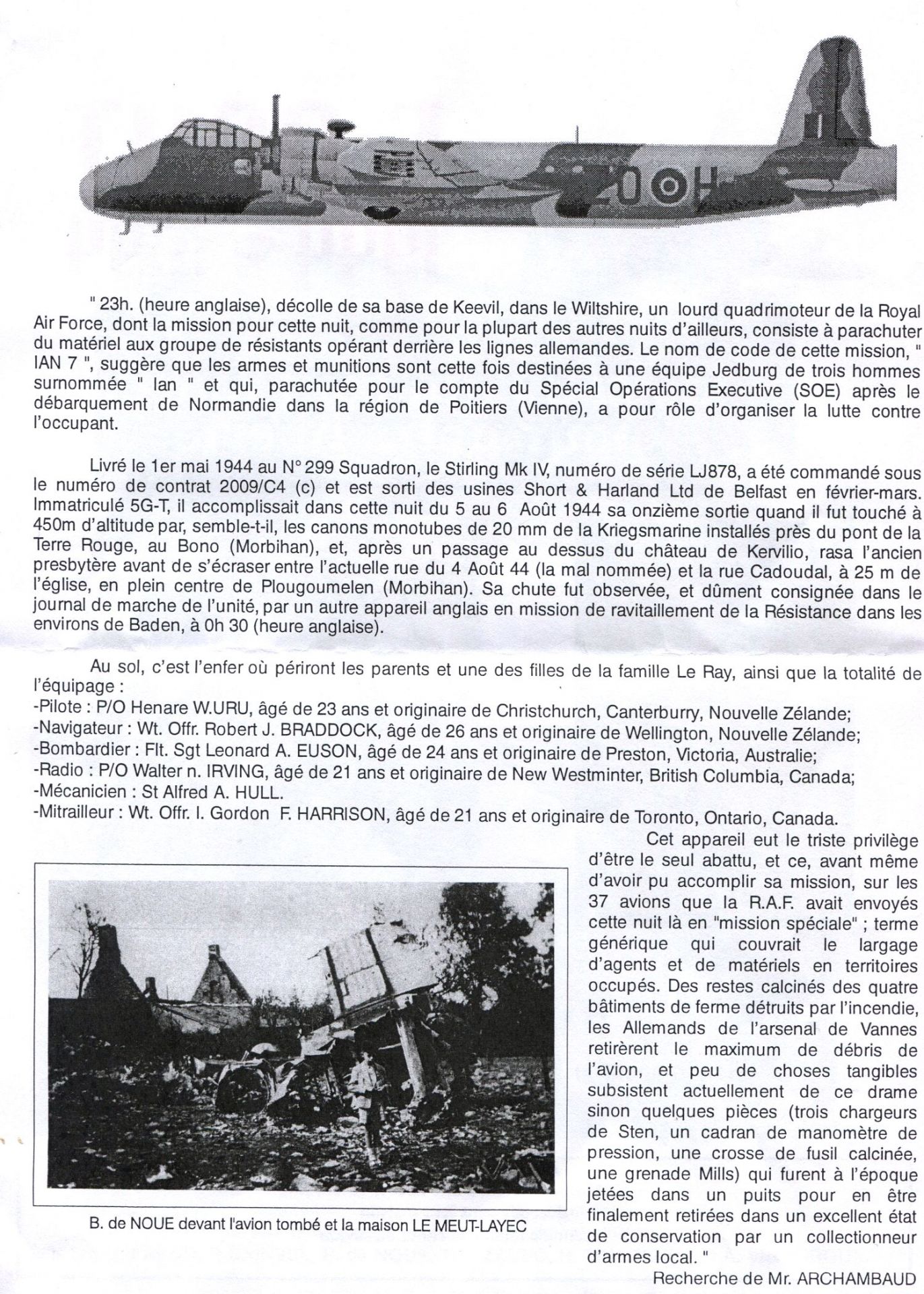
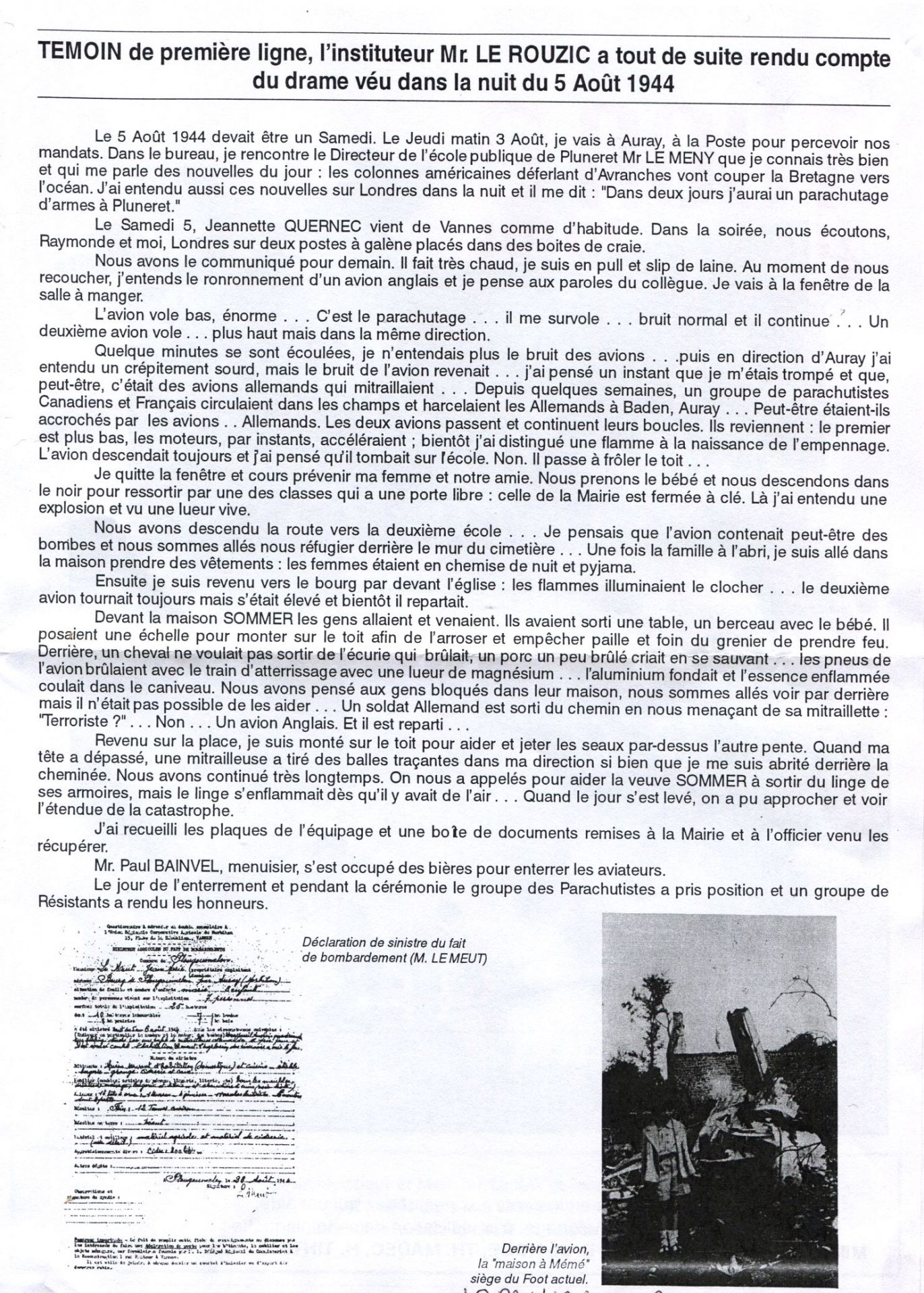
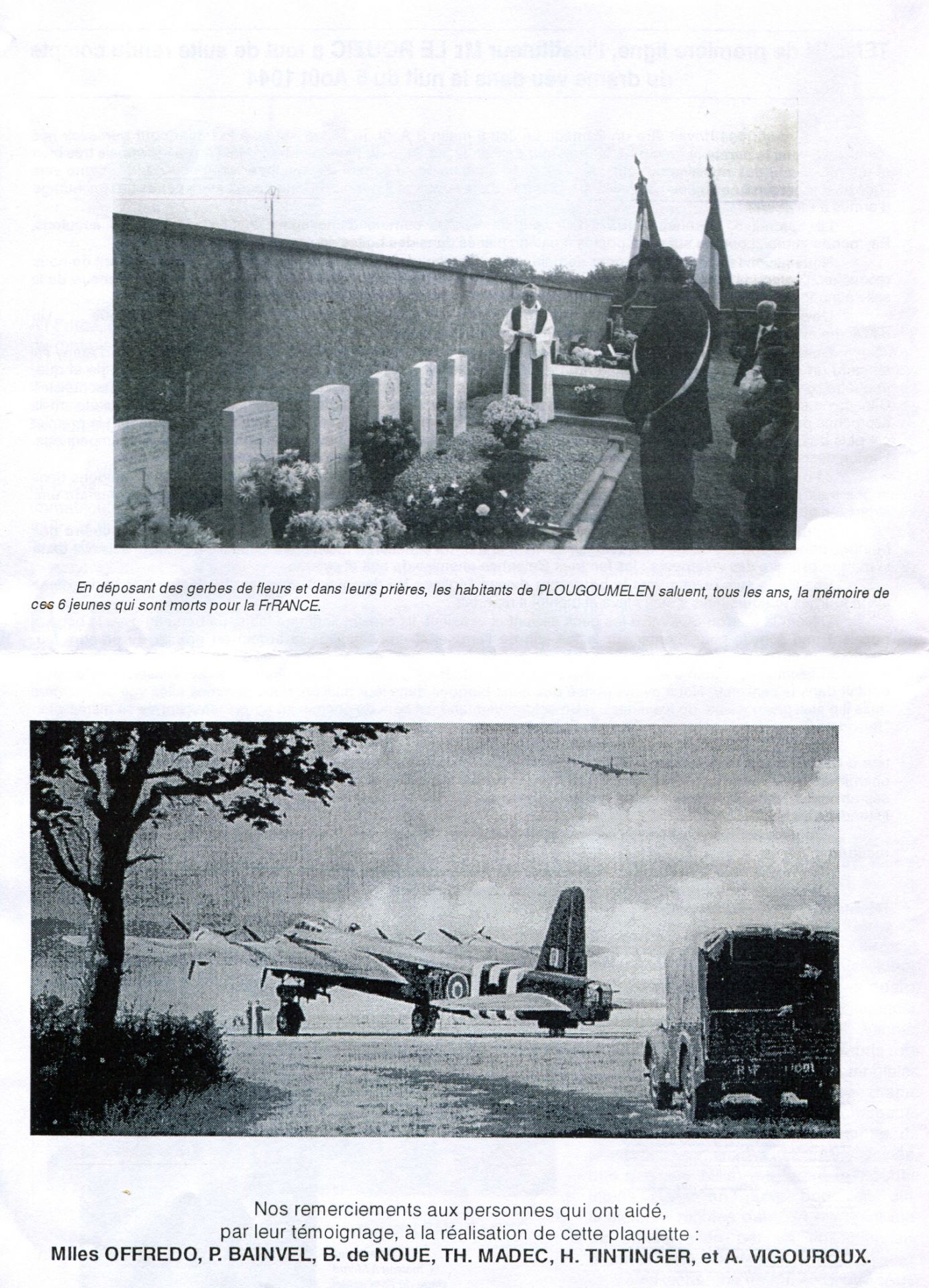
A BRIEF HISTORY OF 299 SQUADRON RAF
• The RAF base of Stoney Cross
299 Squadron was formed on 4 November 1943 at RAF Stoney Cross from 297 Squadron "C" Fighter Squadron. The flying personnel, 210 people, was made up of 42 crews of 5 members. Ground staff, 200 people. The first commander of 299 Squadron was Wing Commander R.W.G. KITLEY who was previously the commander of 297 Squadron.
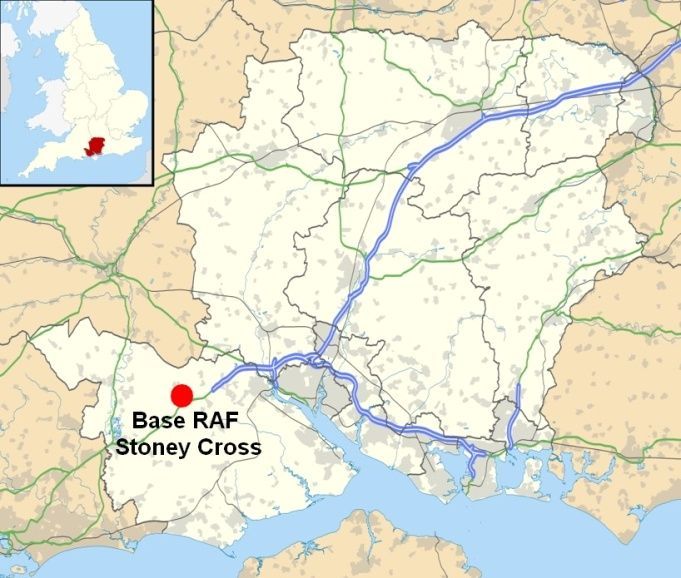
Location of RAF Base Stoney Cross
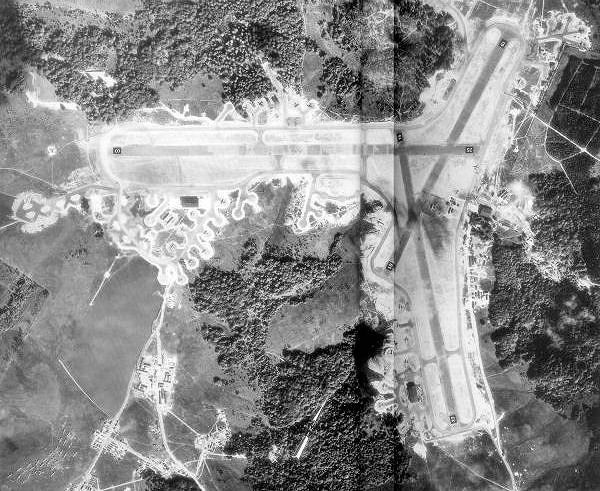
Aerial view of Stoney Cross base - Photo : United Kingdom Government - Public Domain
The objective of the creation of this squadron was to train a unit, of the 38th Group of the RAF, in towing gliders and dropping paratroopers. 299 Squadron was equipped with Lockheed Ventura Mk I and Mk II twin-engine bombers.

Lockheed Ventura Mk I, AE762,Speke Airport, Liverpool. The AE762 was used by 21 and 299 Squadrons RAF
Photo : United Kingdom Government - Public Domain - © Imperial War Museum IWM ATP 10835B
Then the 299 squadron was converted to the Stirling bomber. On December 8, 1943, 8 crews were transferred to "1665 Heavy Conversion Unit" at RAF Woolfox Lodge, Rutland County, for training on four-engine Short Stirling bombers. This training was attended by all crews. On December 28, 1943, Wing Commander P.B.N. DAVIS was appointed commander of 299 Squadron. On January 2, 1944, the first Stirling Mk IV bomber was delivered to 299 Squadron by the "19 Maintenance Unit" at St Athan Base in Wales. January 30, 1944, start of training with the Stirling bombers. On January 31, 1944, the 299 squadron was equipped with 19 Stirling Mk IVs ; 2 of them were modified for towing gliders. On 12 February 1944, the crew of Flight Sergeant URU returned to 299 Squadron after Stirling bomber training at 1665 Heavy Conversion Unit at RAF Base Tilstock, County Shropshire. On March 15, 1944, 299 Squadron was transferred to RAF Base Keevil. On Wednesday April 5, 1944 the 299 squadron operated its first operational mission. Three crews operated from the RAF base of Tarrant Rushton an operation to drop weapons, ammunition and supplies for the S.O.E. in France.
• Operational missions, listed in chronological order, performed by the crew of Flight Sergeant URU (11 operational missions) with Stirling IV, coded 5G-T, serial number LJ878 :
- Friday 28th April, 1944.
1st operational mission of the URU crew. Stirling IV. Coded: 5G-S, Serial No. LJ919. Crew: F/Sgt URU, F/Sgt BRADDOCK, F/Sgt EUNSON, F/Sgt TAYLOR, F/Sgt HARRISON, Sgt HULL. Take off at 10:22 p.m. from RAF base Tarrant Rushton. SOE operation in Aire-sur-Adour (40). Parachuting of 15 containers and 3 packets. Not done due to weather conditions. Landed at 4:30 a.m. at Tarrant Rushton.
- Sunday 7th May, 1944.
2nd operational mission of the URU. Stirling IV crew. Coded : 5G-Z, serial no. LJ955. Crew: F/Sgt URU, F/Sgt BRADDOCK, F/Sgt EUNSON, F/Sgt TAYLOR, F/Sgt HARRISON, Sgt HULL. Take off at 10:50 p.m. from RAF base Tarrant Rushton. SOE operation at La Coquille (Dordogne). Dropping of 24 containers and 3 packages not operated. No reception committee. Returned and landed at 5:00 a.m. in Tarrant Rushton
- Wednesday 10th May, 1944
1st operational mission of the Stirling Mk IV. Coded: 5G-T. Serial number: LJ878. Crew: S/Ldr DALE, F/S WATKINS, F/S GRANT, Sgt NEWTON, F/O MASSEY, Sgt DAY. Take off at 10:00 pm from RAF base Tarrant Rushton. Operation SOE. Parachuting of 24 containers and 3 packets operated. Returned and landed at 5:20 a.m. in Tarrant Rushton.
- Monday 29th May, 1944.
2nd operational mission of the Stirling Mk IV. Coded: 5G-T. Serial number: LJ878. Crew: F/O FARRELL, F/Sgt BOA, F/Sgt EDE, W/O RAMSDEN, W/O McLEOD, Sgt BAKER. Takeoff at 10:45 p.m. from Tarrant Rushton's RAF base. Operation SOE. Parachuting not performed. Reason unknown. Landed at 3:45 a.m. at Tarrant Rushton.
- Monday 5th June, 1944.
3rd operational mission by the URU crew. Stirling Mk IV. Coded: 5G-X, Serial No.: LJ874. Crew: F/Sgt URU, F/Sgt BRADDOCK, F/Sgt EUNSON, F/Sgt TAYLOR, F/Sgt HARRISON, Sgt HULL. Take off at 11.57 p.m. at RAF base Keevil. Operation Overlord, "Tonga". Successful parachute drop of 17 paratroopers and 9 containers. Aircraft damaged by light flak. F/Sgt TAYLOR, radio operator/gunner, was wounded. Returned and landed at 3:15 a.m. in Keevil.
- Monday 5th June, 1944.
3rd operational mission of the Stirling Mk IV. Coded: 5G-T. Serial number: LJ878. Crew: F/O FARRELL, F/Sgt BOA, F/Sgt EDE, W/O RAMSDEN, W/O McLEOD, Sgt BAKER. Take off at 11:50 p.m. from RAF base Keevil. Operation Overlord, "Tonga". Successful parachute drop of 20 paratroopers and 9 containers. Aircraft slightly damaged by light Flak. Returned and landed at 4:30 in Keevil.
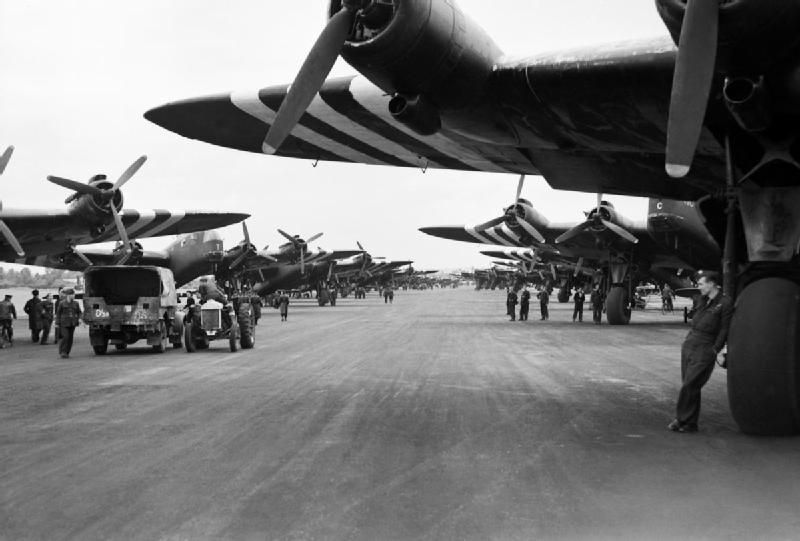
Short Stirling Mk IV of No 196 and No. 299 Squadrons RAF line up on the runways at Keevil on the evening of 5 June 1944
Photo : United Kingdom Government - Public Domain - © Imperial War Museum IWM CH 13298
- Tuesday 6th June 1944.
4th operational mission of the Stirling Mk IV. Coded: 5G-T. Serial number: LJ878. Crew: F/O FARRELL, F/Sgt BOA, F/Sgt EDE, W/O RAMSDEN, W/O McLEOD, Sgt BAKER. Takeoff at 7.21 p.m. from RAF base Keevil. Operation Overlord, "Mallard". Towing and dropping of a glider operated. (Glider pilot: Lieutenant CHITTLEBURG). Returned and landed at 4:50 in Keevil.
- Monday 12th, June 1944.
4th operational mission by the URU crew. From this 4th operational mission, F/Sgt TAYLOR, injured, was replaced by W/O IRVING in the crew of F/Sgt URU. Stirling Mk IV. Coded: X9-Y. Crew: F/Sgt URU, F/Sgt BRADDOCK, F/Sgt EUNSON, W/O IRVING, F/Sgt HARRISSON, Sgt HULL. Take off at 10:05 p.m. from RAF Fairford. SAS operation, "Sunflower IV". Successful parachute drop of 15 paratroopers and 14 containers. Returned and landed at 2:50 am in Fairford.
- Friday 16th June, 1944.
5th operational mission of the Stirling Mk IV. Coded: 5G-T. Serial number: LJ878. Stirling Mk IV. Coded: 5G-T, Serial No.: LJ878. Crew: F/O FARRELL, P/O EDE, F/Sgt BOA, W/O RAMSDEN, W/O McLEOD, Sgt BAKER. Take off at 11:30 p.m. from RAF base Keevil. Operation "Bulbasket", Successful parachute drop of 24 containers. Returned and landed at 4:50 in Keevil.
- Sunday 18th June, 1944.
6th operational mission of the Stirling Mk IV. Coded: 5G-T. Serial number: LJ878. Crew: F/O HULL, F/Sgt JORDON, F/Sgt HARRIS, Sgt ROME, F/Sgt WAINWRIGTH, Sgt MURRAY. Takeoff at 8:26 p.m. from RAF base Keevil. Operation "Townhall". Successful parachute drop of 21 containers. 3 containers brought back. Returned and landed at 10:53 p.m. in Keevil.
- Friday 23rd June, 1944.
6th operational mission by the URU crew. Stirling Mk IV. Coded: X9-C. Crew: F/Sgt URU, W/O BRADDOCK, F/Sgt EUNSON, W/O IRVING, F/Sgt HARRISSON, Sgt HULL. Take off at 7:18 p.m. at RAF base Keevil. Operation "Townhall". Successful parachute drop. Returned and landed at 10:10 p.m. in Keevil.
- Thursday 6th July, 1944.
7th operational mission of the Stirling Mk IV. Coded: 5G-T. Serial number: LJ878. Crew: F/O FARRELL, P/O EDE, F/Sgt BOA, W/O RAMSDEN, W/O McLEOD, Sgt BAKER. Take off at 10:40 p.m. from RAF base Tarrant Rushton. Operation SOE. Successful parachute drop of 21 containers. 3 containers brought back. Returned and landed at 4:20 a.m. in Tarrant Rushton.
- Thursday 6th July, 1944.
7th operational mission by the URU crew. Stirling Mk IV. Coded: X9-Y. Crew: W/O URU, W/O BRADDOCK, F/Sgt EUNSON, W/O IRVING, F/Sgt HARRISON, Sgt HULL. Take off at 10:50 p.m. from RAF base Tarrant Rushton. Operation SOE. Successful parachute drop. Returned and landed at 4:20 a.m. in Tarrant Rushton.
- Monday 10th July, 1944.
8th operational mission of the Stirling Mk IV. Coded: 5G-T. Serial number: LJ878. Crew: F/O FARRELL, F/Sgt EDE, F/Sgt BOA, W/O RAMSDIN, W/O McLEOD, Sgt BAKER. Take off at 1h15 am from the RAF base of Tarrant Rushton. Operation SOE. Parachuting not operated. No reception committee. Returned and landed at 5:30 a.m. in Tarrant Rushton.
- Tuesday 11th July, 1944.
8th operational misison by the URU crew. Stirling Mk IV. Coded: 5G-X, Serial No.: LJ874. Crew: W/O URU, W/O BRADDOCK, F/Sgt EUNSON, W/O IRVING, F/Sgt HARRISON, Sgt HULL. Take off at 00:00 from RAF base Keevil. Operation SOE. Parachuting not operated, no reception committee. Returned and landed at 5:30 a.m. in Keevil
- Friday 14th July, 1944.
9th operational mission of the Stirling Mk IV. Coded: 5G-T. Serial number: LJ878. Crew: F/O FARRELL, F/Sgt EDE, F/Sgt BOA, W/O RAMSDIN, W/O McLEOD, Sgt BAKER. Takeoff at 0:30 am from RAF base Keevil. Operation SOE. Successful parachute drop of 24 containers. Returned and landed at 3:50 in Keevil.
- Thursday 20th July, 1944.
10th operational mission of the Stirling Mk IV. Coded: 5G-T. Serial number: LJ878. Crew: F/O FARRELL, F/Sgt EDE, F/Sgt BOA, W/O RAMSDIN, W/O McDONALD, Sgt BAKER. Takeoff at 10:53 p.m. from RAF base Keevil. SAS operation. Successful parachute drop of 24 containers. Returned and landed at 4:08 in Keevil.
- Saturday 29th July, 1944.
9th operational mission by the URU crew. Stirling Mk IV. Coded: 5G-X, Serial No.: LJ874. Crew: P/O URU, W/O BRADDOCK, F/Sgt EUNSON, P/O IRVING, W/O HARRISON, Sgt HULL. Take off at 2.30 am from RAF base Keevil. Operation SOE. Successful parachute drop. Returned and landed at 7:40 a.m. in Keevil.
- Wednesday 2nd August, 1944.
10th operational mission by the URU crew. Stirling Mk IV. Coded: 5G-U, Serial No: LK 118. Crew: P/O URU, W/O BRADDOCK, F/Sgt EUNSON, P/O IRVING, W/O HARRISON, Sgt HULL. Take off at 23:00 from RAF base Keevil. SAS Operation, "Dingson 32B". Successful parachute drop of 24 containers. Letter code DZ: X. Light Flak fire at Auray. Landed at 3:15 a.m. at RAF Davidstow Moor.
- Saturday 5th August, 1944.
11th operational mission by the URU crew. 11th operational mission of the Stirling Mk IV. Coded: 5G-T. Serial number: LJ878. Crew: P/O URU, W/O BRADDOCK, F/Sgt EUNSON, P/O IRVING, W/O HARRISON, Sgt HULL. Take off at 23:00 from RAF base Keevil. SAS Operation, "Dingson 35B". Parachuting of 24 containers not operated. No reception committee. Aircraft hit by light German flak at Terre-Rouge in Auray and crashed in the town of Plougoumelen.

Ajouter un commentaire